Nestled in the heart of East Asia, Japan beckons travelers with its magnetic allure—a captivating blend of ancient traditions and cutting-edge technology. The Land of the Rising Sun, as it’s often called, boasts a kaleidoscope of experiences that leaves a lasting impression on the millions of visitors who flock to its shores yearly. From the bustling metropolises of Tokyo and Osaka to the tranquil countryside and historic temples of Kyoto and Nara, Japan offers a journey that caters to all tastes and interests.
If you’re planning a trip to Japan, prepare to embark on an adventure that transcends typical tourist paths. The country’s diverse tapestry of experiences awaits, allowing you to dive into the heart of its culture, traditions, and passions. Japan offers more than just a simple visit. You can indulge in the finest local delicacies, engage in traditional practices, cheer on sumo wrestlers, and bask in the therapeutic waters. Japan invites you to fully participate in its dynamic culture, creating an unforgettable experience.
As you plan your voyage to this enchanting nation, you’ll soon realize that the most challenging decision is not whether to visit but where to explore first. With a seemingly endless array of remarkable destinations, each with its unique charm and character, Japan invites you to dive deep into its vibrant tapestry.
The Top Places To Visit In Japan By The Sakura Chronicles Guide
In this comprehensive guide, we’ll be your compass through this captivating land, unveiling Japan’s top places to visit. Whether you’re a fan of history and culture, a nature enthusiast seeking breathtaking landscapes, a culinary adventurer ready to savor exquisite local cuisines, or simply a traveler yearning for a taste of everything, we’ve got you covered.
So, fasten your seatbelts, dear travelers, as we journey through Japan’s top ten destinations that will ignite your wanderlust and inspire your next adventure. From the modern metropolis of Tokyo to the historic streets of Kyoto, from the culinary delights of Osaka to the poignant history of Hiroshima, we’ll take you on a virtual tour of these incredible places, offering insights, tips, and recommendations to make your trip to Japan unforgettable. Whether you’re a first-time visitor or a seasoned explorer, there’s always something new to discover in Japan, and we’re here to guide you every step of the way.
Tokyo: Where Tradition and Modernity Converge
In the heart of Japan, amid the iconic blend of tradition and modernity, lies Tokyo, a sprawling metropolis that never ceases to amaze. This bustling capital city is a captivating mosaic of diverse neighborhoods offering unique charm and experiences. From the neon-lit streets of Shinjuku to the youthful energy of Shibuya and the timeless traditions of Asakusa, Tokyo beckons travelers to embark on a journey of discovery. Discover three captivating neighborhoods in Tokyo, each with its unique tale to tell and a rich array of experiences just waiting to be explored. So, fasten your seatbelts and explore the top places to visit in Tokyo, where every corner reveals a new adventure.
Shibuya: Where Youthful Energy and Fashion Collide
Shibuya takes center stage when it comes to experiencing the vibrant pulse of Tokyo’s youth culture. This dynamic district is a playground for trendsetters, fashion enthusiasts, and those seeking the beating heart of modern Tokyo.
Shibuya Crossing: The Iconic Chaos
At the heart of Shibuya lies its most iconic attraction—the Shibuya Crossing. This lively scramble crossing is renowned for being one of the most heavily trafficked intersections in the world. Its impressive display of controlled pandemonium is genuinely mesmerizing. When the traffic lights turn red, a torrent of pedestrians floods the intersection from all directions, creating a mesmerizing sea of people in motion. Watching this synchronized dance from above, perhaps from the second-floor Starbucks at the Shibuya Tsutaya building, is an absolute must.
Hachiko Statue: The Most Famous Tale of Loyalty In Japan
Adjacent to Shibuya Crossing stands the beloved Hachiko Statue. This loyal Akita dog waited at Shibuya Station every day for his owner, even after his owner’s passing. Hachiko’s story of unwavering loyalty has touched the hearts of many and made this statue a popular meeting point for locals and tourists alike.
Shibuya 109: Trendsetting Fashion
Fashionistas, take note: Shibuya is synonymous with style. Shibuya 109, a landmark department store, is a fashion mecca for those seeking the latest clothing, accessories, and cosmetics trends. It’s a multi-story haven of boutiques, each offering its unique take on contemporary Japanese fashion. From streetwear to high-end couture, Shibuya 109 has it all.
Center Gai: Shopping, Dining, and More
Center Street, or “Center Gai,” is a bustling pedestrian street in Shibuya with diverse shops, boutiques, restaurants, and karaoke bars. It’s a microcosm of Shibuya’s energetic and ever-evolving culture. Whether you’re in the mood for street food, a shopping spree, or a night of singing, Center Gai has something for everyone.
Nightlife and Entertainment In Shibuya, Japan
Shibuya doesn’t sleep when the sun goes down. The district comes alive with its vibrant nightlife, offering many bars, clubs, and entertainment venues. Whether you’re into electronic dance music, live jazz, or enjoying a quiet drink with friends, Shibuya’s nightlife scene caters to all tastes.
Discovering Hidden Gems
Although Shibuya Crossing and Shibuya 109 are must-see attractions, there are still many other treasures scattered around Shibuya that are worth uncovering. Explore the side streets and alleys to find charming cafes, intimate live music venues, and quirky shops selling unique souvenirs. The essence of Shibuya often lies in these less-trodden paths, where you can soak in the local atmosphere and perhaps stumble upon your next favorite haunt.
Cultural Fusion: Shibuya’s Diversity
Shibuya’s popularity transcends borders, making it a hub for cultural exchange. You’ll encounter people worldwide in this district, drawn by its magnetic energy. The diversity of cultures, languages, and styles adds to Shibuya’s vibrant tapestry and offers a truly global experience.
A Neighborhood That Never Sleeps
Shibuya truly lives up to its reputation as a neighborhood that never sleeps. There’s always something happening here from the early hours of the morning until late at night. Whether you want to enjoy a leisurely brunch, shop for the latest fashion trends, or dance the night away, Shibuya has you covered.
Shibuya is a district that embodies Tokyo’s youthful energy and trendsetting spirit. From the iconic Shibuya Crossing to the touching tale of Hachiko and from fashion-forward shopping to electrifying nightlife, this neighborhood is a captivating microcosm of modern Japan. Join us as we explore Shibuya in more detail, uncovering its hidden gems and vibrant culture, making it a must-visit destination in Tokyo.

Shinjuku: Where Skyscrapers, Nightlife, and Shopping Collide
In the heart of Tokyo, the sprawling skyscrapers and bustling streets of Shinjuku create an urban landscape that’s nothing short of mesmerizing. This vibrant neighborhood is a thrilling blend of modernity and tradition, where visitors can immerse themselves in many experiences.
Tokyo Metropolitan Government Building: A Panoramic Vista
Your journey into Shinjuku should begin with a visit to the Tokyo Metropolitan Government Building. This architectural marvel offers a glimpse into the inner workings of the city but also a chance to ascend to the 45th-floor observation deck. You can enjoy awe-inspiring views of Tokyo’s skyline from this point. The vista is a sight to behold whether you visit during the day or night.
Kabukicho: The Nighttime Playground Of Japan
As the sun sets, Kabukicho comes to life. This bustling entertainment district in Shinjuku is known for its vibrant nightlife and various entertainment options. From karaoke bars to themed restaurants and dazzling neon lights, Kabukicho offers an electrifying atmosphere. Explore the maze-like streets, and you’ll find many experiences, from traditional izakayas to modern clubs.
Golden Gai: A Nostalgic Experience
Adjacent to Kabukicho lies Golden Gai, a historic area known for its narrow alleyways and tiny bars. Stepping into Golden Gai feels like entering a different era, where post-war nostalgia lingers. Each minuscule bar has its unique charm and theme, making it an excellent place for an intimate night out and a chance to mingle with locals and fellow travelers.
Shopping Extravaganza
Shinjuku is a shopaholic’s paradise. You’ll find it all, from luxury boutiques in the Isetan Department Store to the electronic wonderland of Yodobashi Camera. Don’t forget to explore the underground shopping streets of Shinjuku Station, where you can discover an array of unique boutiques, souvenir shops, and gourmet food stalls.
Shinjuku Gyoen National Garden: A Tranquil Oasis in the Heart of Tokyo
In the heart of Tokyo’s bustling urban landscape, where towering skyscrapers and neon lights dominate the skyline, a hidden gem offers respite from the chaos and a glimpse into the serenity of nature. Shinjuku Gyoen National Garden, an expansive oasis nestled amidst the concrete jungle, is a testament to the harmonious coexistence of the artificial and the natural world.
A Tapestry of Garden Styles
This park showcases the intricate beauty of Japanese horticultural artistry and covers an impressive 144 acres. Its grounds are divided into several distinct garden styles, each with a unique charm.
Tranquility in Japanese Tradition
The traditional Japanese garden, with its meticulously pruned bonsai trees and carefully raked gravel paths, evokes a sense of tranquility and mindfulness. Here, visitors can experience the essence of Zen philosophy as they meander along winding paths, passing by ornate stone lanterns and koi-filled ponds.
European Elegance in Tokyo
On the other hand, the French formal garden transports visitors to the grandeur of European aristocracy. Lush lawns, symmetrical flower beds, and neatly trimmed hedges create an atmosphere of sophistication and elegance. It’s a perfect spot for a leisurely picnic or to simply bask in the beauty of the meticulously maintained flora.
A Global Botanical Showcase
Shinjuku Gyoen also boasts an English landscape garden, where vast expanses of green grass and a picturesque lake reflect the influence of Western gardening traditions. Here, visitors can enjoy the spectacle of cherry blossoms in spring or the vibrant foliage of maple trees in autumn. The changing seasons bring a kaleidoscope of colors to the garden, making it a perennial favorite among locals and tourists alike.
As you explore the garden’s meandering paths, you’ll encounter various plant species worldwide. The park is a living museum of botanical diversity, from cherry blossoms (sakura) and plum trees (ume) to roses and camellias. There’s always something in bloom, ensuring each visit is a unique experience.
A Living Heritage
Shinjuku Gyoen National Garden isn’t just a place for leisurely walks and botanical exploration; it’s also a testament to Japan’s commitment to preserving its natural heritage amid urban development. In the Edo period, the Naito family undertook extensive renovations of their private garden and converted it into a botanical garden. This beautiful space was officially recognized as a national garden in 1949 and has been a beloved destination for visitors ever since. Its history is intertwined with the evolution of Japan itself, making it not just a place of beauty but also a living testament to the country’s cultural heritage.
Whether you’re a nature enthusiast, a photographer seeking picturesque scenes, or simply looking for calm amidst the bustling city, Shinjuku Gyoen National Garden offers an oasis of tranquility and natural beauty. It’s a place where the old and new, tradition and modernity, seamlessly blend into an unforgettable experience that captures the essence of Japan. So, step inside this verdant haven, take a deep breath, and let the serenity of Shinjuku Gyoen wash over you as you escape the urban hustle and bustle for a while.
Omoide Yokocho: A Taste of Yesteryears
Amidst the towering skyscrapers and high-tech marvels of Tokyo’s bustling city center, a remarkable time capsule awaits, offering a glimpse into Japan’s bygone era’s rich cultural heritage and traditions. Step inside and be transported back in time to where old Japan’s sights, sounds, and scents come alive, evoking a sense of nostalgia and wonder that will stay with you forever. Omoide Yokocho, affectionately known as “Memory Lane,” is an atmospheric alleyway that beckons those seeking an authentic taste of traditional Japanese street food and the sizzle of yakitori (grilled chicken skewers). While it has also been dubbed “Piss Alley” in the past, this moniker is gradually fading away, giving precedence to its more fitting and endearing name, Omoide Yokocho.
A Culinary Journey Back in Time
Omoide Yokocho is a culinary treasure trove, an alleyway steeped in history and rich in gastronomic delights. The narrow lane has a charming array of tiny eateries and stalls, each with unique character and culinary offerings. As you stroll through this alley, the aroma of sizzling meats and savory broths wafting from the open grills and steaming pots is enchanting.
Yakitori Galore
The undisputed star of Omoide Yokocho is yakitori. These delectable skewers of grilled chicken, carefully marinated and seasoned to perfection, are prepared right before your eyes by skilled chefs who have mastered the art of balancing flavors and textures. From succulent thigh meat to crispy skin and everything in between, the variety of yakitori offered here is bound to tantalize your taste buds. Pair your skewers with a cold beer or a glass of sake for the ultimate culinary experience.
A Feast Beyond Yakitori
While yakitori takes center stage, Omoide Yokocho offers a diverse menu beyond grilled chicken. You can sample a plethora of other Japanese street food classics, such as takoyaki (octopus balls), okonomiyaki (savory pancakes), and gyoza (dumplings). Each tiny eatery specializes in its signature dishes, ensuring something to satisfy every palate.
Nostalgia in Every Corner
Beyond the delectable cuisine, Omoide Yokocho exudes an ambiance of nostalgia. The narrow alleyway, lined with traditional paper lanterns and rustic wooden facades, evokes the bygone era of post-war Tokyo. It’s a place where time seems to stand still, allowing you to savor not only the flavors but also the cultural heritage of Japan.
A Culinary Adventure Awaits
Omoide Yokocho is a must-visit location in Tokyo, whether you’re an avid foodie searching for authentic Japanese street food or just looking to experience the charm of old Tokyo amidst the modern city. Here, the warmth of the grill, the tantalizing aromas of skewers sizzling, and the nostalgic atmosphere all come together to create an unforgettable dining experience. So, step into this charming alley and take a culinary journey back in time, one mouthwatering bite at a time, and discover why Omoide Yokocho is a cherished memory for all who visit.
Shinjuku Sanchome: A Fashionista’s Paradise
In the heart of Tokyo, where fashion is more than just clothing; it’s a way of life, Shinjuku Sanchome emerges as a vibrant epicenter for style-conscious travelers. This district surrounding the bustling Shinjuku Sanchome Station is not just a shopping destination; it’s a pilgrimage for those pursuing the latest trends, high-end couture, and unique fashion finds.
An Eclectic Fashion Landscape
Shinjuku Sanchome offers an eclectic fashion landscape, catering to a diverse range of tastes and preferences. As you venture into this style mecca, you’ll find yourself navigating through a tapestry of fashion boutiques, each with its distinct character. Whether you are seeking haute couture, streetwear, vintage treasures, or cutting-edge designs, this neighborhood has it all.
High-End Haute Couture
For those with a penchant for luxury and designer labels, Shinjuku Sanchome boasts an array of high-end boutiques that redefine the concept of sartorial elegance. Internationally renowned fashion houses have set up shop here, showcasing their latest collections and ensuring that fashion-forward travelers can indulge in the finest apparel, accessories, and footwear.
Independent Boutiques and Emerging Designers
Beyond the glittering facades of luxury brands, Shinjuku Sanchome is also a haven for independent boutiques and emerging designers. These hidden gems offer a glimpse into the cutting-edge of Japanese fashion. Here, you can stumble upon one-of-a-kind pieces crafted by talented local designers, ensuring that your fashion choices are as unique as your style.
The Intersection of Tradition and Innovation
What sets Shinjuku Sanchome apart is its ability to seamlessly blend tradition and innovation. Contemporary fashion stores coexist harmoniously with shops offering traditional Japanese attire like kimonos and yukatas. This juxtaposition of old and new provides a multi-faceted fashion experience, where you can pay homage to Japan’s rich cultural heritage while embracing the avant-garde.
Exploration Beyond Fashion
While Shinjuku Sanchome is undeniably a fashion lover’s paradise, it offers more than just shopping. The streets buzz with energy, and you’ll find stylish cafes, art galleries, and beauty salons, all contributing to the district’s vibrant atmosphere. It’s not just about what you wear but also about immersing yourself in the entire fashion culture of Tokyo.
A Fashion Journey Awaits
Whether you’re a seasoned fashionista or looking to revamp your wardrobe with a touch of Tokyo’s unique style, Shinjuku Sanchome beckons with open arms. It’s a place where fashion isn’t just about dressing up; it’s about self-expression and creativity. So, set foot in this fashionable district, let the streets guide you through a world of trends, designs, and inspiration, and discover why Shinjuku Sanchome is an indispensable destination for those who live and breathe fashion.
A Neighborhood That Never Sleeps
Shinjuku’s nickname, “The City That Never Sleeps,” is well-deserved. The neighborhood buzzes with activity 24/7, offering various experiences catering to every interest. Shinjuku has it all, whether you’re a night owl seeking vibrant nightlife or a shopper with a penchant for luxury.
Shinjuku is a neighborhood that epitomizes Tokyo’s modernity and its unwavering energy. This district has something for every traveler, from stunning city views to bustling nightlife and hidden alleys to serene parks. Join us as we delve deeper into Shinjuku, exploring its multifaceted charm and uncovering the experiences that make it an essential part of any Tokyo adventure.
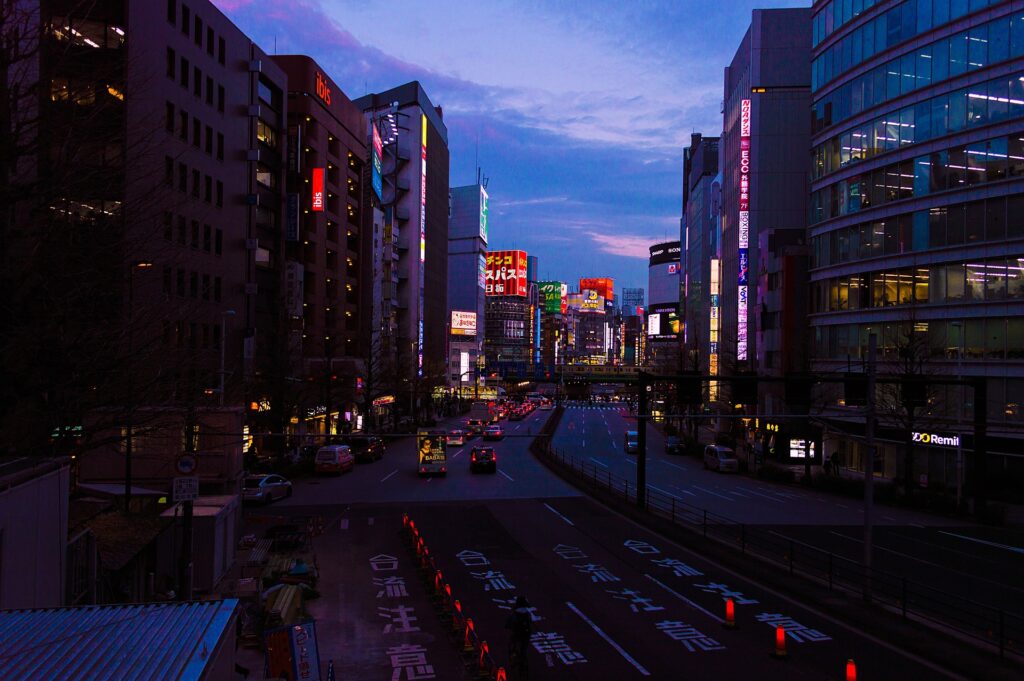
Asakusa: Where Tradition Meets Tokyo’s Modernity
In the sprawling metropolis of Tokyo, where cutting-edge technology and contemporary architecture dominate the cityscape, a neighborhood stands as a living testament to Japan’s rich cultural heritage. Asakusa, a captivating blend of the old and the new, has become a must-visit destination for travelers seeking a glimpse into the country’s history, spirituality, and vibrant traditions.
Sensoji Temple: A Timeless Spiritual Icon
At the heart of Asakusa lies the Sensoji Temple, a hallowed ground that has drawn pilgrims and tourists alike for over a millennium. Founded in the year 628 AD, it holds the distinction of being Tokyo’s oldest and most significant Buddhist temple. As you approach its iconic Thunder Gate (Kaminarimon), you’re greeted by a colossal red lantern, symbolizing the temple and the neighborhood. This gate marks the entrance to the spiritual haven beyond.
Stepping through the gate, you’ll find yourself on Nakamise Street, a bustling thoroughfare lined with colorful stalls and shops offering an array of traditional Japanese souvenirs, crafts, and snacks. This street, which leads to the main hall of Sensoji Temple, provides a sensory journey through time and culture. The temple’s main hall, once you reach it, houses a magnificent golden statue of Kannon, the goddess of mercy, a sight that is both awe-inspiring and spiritually uplifting.
Nakamise Shopping Street: A Treasure Trove of Japanese Heritage
Adjacent to Sensoji Temple, Nakamise Shopping Street is a treasure trove of Japanese heritage. You’ll find a vast collection of Japan’s cultural heritage in every shop and stall here. Beautifully crafted folding fans (sensu), colorful yukatas, elegant porcelain, and many other keepsakes from your visit are available here. It’s not just a shopping experience; it’s a cultural exploration.
Nakamise isn’t just about the material; it’s also about the culinary delights. You’ll encounter a delightful array of Japanese street food stalls as you stroll down the street. You won’t be able to resist the tempting offerings of taiyaki, the fish-shaped pastries filled with sweet and satisfying fillings. Additionally, you’ll find adorable ningyo-yaki, which are doll-shaped cakes sure to put a smile on your face. And don’t forget to try the savory senbei rice crackers – they’re a must-try treat! These treats offer a journey through the diverse flavors of Japan, with each bite revealing a bit of culinary tradition.
A Glimpse into Tokyo’s Diversity
Asakusa effortlessly blends the past and present, with contemporary stores, coffee shops, and entertainment spots coexisting perfectly with its historical attractions. This charming neighborhood is not just a relic of the past but a vibrant and dynamic part of modern Tokyo. After exploring the temple and the shopping street, you can stroll along the Sumida River, visit the towering Tokyo Skytree for panoramic views of the city, or explore the vibrant nightlife just a stone’s throw away.
A Tokyo Must-Visit
In essence, Asakusa encapsulates Tokyo’s diverse and dynamic character. Whether you’re a history buff, a spiritual seeker, a shopper looking for unique souvenirs, or a food lover eager to explore Japanese cuisine, Asakusa has something to offer. It’s a neighborhood that harmoniously melds the past and the present, the traditional and the modern. A visit to Asakusa is an immersive journey into the heart of Japan’s capital city, offering an unforgettable experience that resonates with the enchanting tapestry of Japanese culture. So, embrace the captivating fusion of tradition and modernity in Asakusa and savor every moment of this Tokyo must-visit destination.

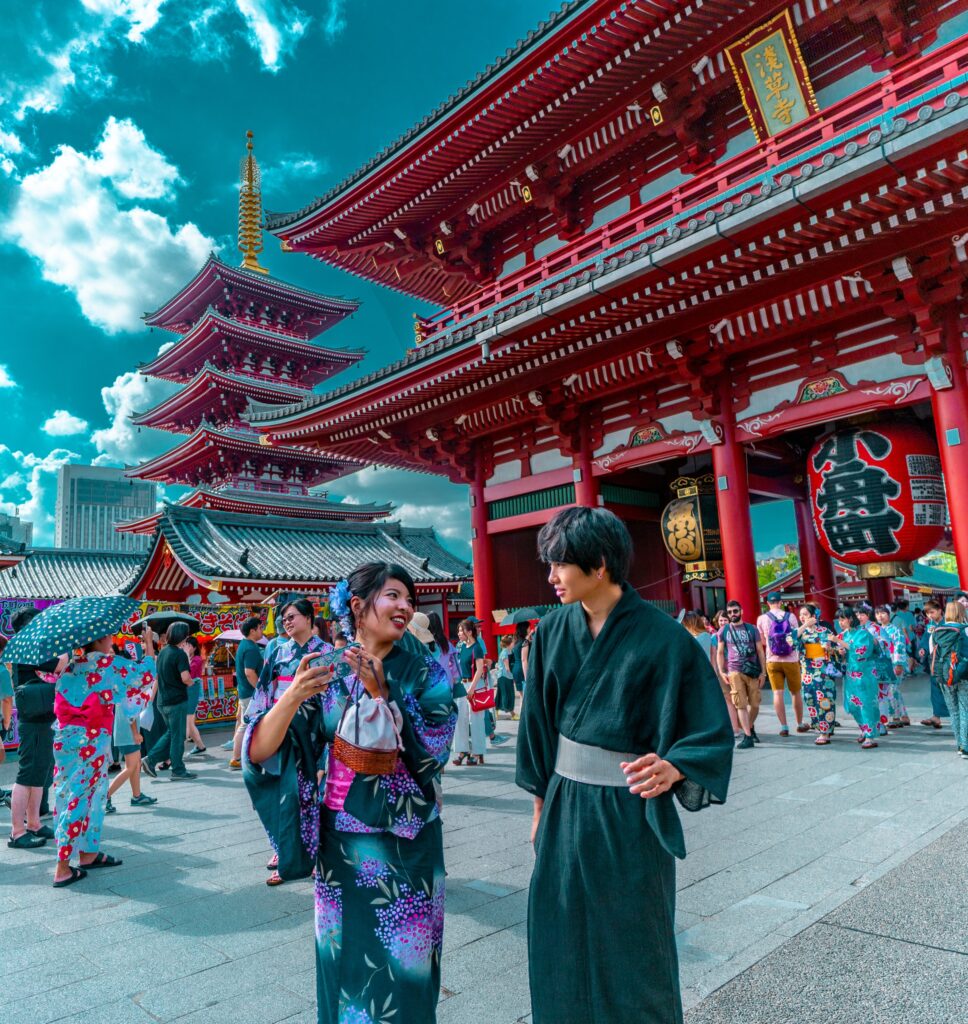

Kyoto: A Timeless Treasure Trove of History and Culture
Imagine a city where time seems to slow, where every street corner whispers secrets from centuries past, and where tradition is not just preserved but celebrated with unparalleled reverence. Come and immerse yourself in the culture and history of Kyoto, located in the heart of Japan’s Kansai region. This enchanting city is not merely a destination; it is a living, breathing testament to Japan’s storied heritage, where the past and the present dance together harmoniously.
In Kyoto, the past is not a distant memory; it is a palpable presence, etched into the timeworn stones of ancient temples, the ornate woodwork of historic shrines, and the hallowed halls of timeless castles. Here, each street, alleyway, and meticulously maintained garden tells a story that spans centuries and invites you to become a part of its ongoing narrative.
Join us on a journey through Kyoto’s top places to visit, where each destination is a chapter in the city’s timeless story. Kyoto beckons with open arms, ready to share its rich tapestry of history, culture, and tradition, from the glistening golden pavilion that seems to touch the heavens to the enchanting bamboo groves that sway in the breeze. So, let us embark on this voyage through the heart of Kyoto, where every step is a step back in time, and every moment celebrates Japan’s enduring legacy.
Fushimi Inari Taisha: A Vermilion Path to Serenity
Hidden amidst the bustling streets and vibrant culture of Kyoto lies a spiritual oasis that beckons travelers worldwide – Fushimi Inari Taisha. This Shinto shrine is not just a place of worship; it’s a captivating visual masterpiece, a cultural treasure trove, and a spiritual journey. As you approach its sacred grounds, you’re immediately greeted by a breathtaking sight synonymous with Kyoto itself – thousands of vermilion torii gates, forming a vivid ribbon that gracefully winds up the mountain behind the shrine.
A Sea of Vermilion Torii Gates
The iconic senbon torii, or “thousand torii gates,” cast a mesmerizing spell upon all who enter. Each gate, painted in a brilliant shade of vermilion, symbolizes devotion, generosity, and aspiration. Donated by individuals, families, and businesses, these gates serve both as offerings to the gods and as a reflection of countless pilgrims’ collective dreams and aspirations. Walking through this vibrant tunnel-like pathway is like stepping into a world where earthly worries fade and spiritual connection flourishes.
A Spiritual Ascent
As you ascend the trail through the Torii gates, you’re not merely embarking on a physical journey; you’re also on a spiritual quest. The path takes you deeper into the embrace of the serene forested landscape of Mount Inari, where the soothing sounds of rustling leaves and chirping birds replace the city’s hustle and bustle. Along the way, you’ll encounter smaller shrines and statues with unique significance, inviting you to pause, reflect, and offer your prayers.
Photographer’s Paradise
Fushimi Inari Taisha is a dreamlike canvas for photographers and social media enthusiasts. The striking contrast between the vermilion gates and the lush greenery of the forest creates a visual symphony that is nothing short of captivating. The interplay of light and shadow, especially during the enchanting moments of sunrise or sunset, transforms the scene into a palette of ever-changing hues, making it an irresistible subject for photographers from every corner of the globe.
A Place of Pilgrimage
Beyond its aesthetic appeal, Fushimi Inari Taisha is a sacred place of pilgrimage. This holy site is a tribute to Inari Okami, the revered deity of rice, prosperity, and triumph. People of diverse backgrounds come here to seek divine favor for their enterprises, professions, and individual goals. The rituals, offerings, and prayers made here are deeply rooted in tradition and faith, creating an atmosphere of profound reverence.
Be Prepared for Crowds
Given its popularity, Fushimi Inari Taisha can get crowded, particularly during weekends and peak tourist seasons. To fully savor the tranquility and spiritual essence of the shrine, it’s advisable to plan your visit during the early morning or late evening hours when the crowds are thinner, and you can enjoy a more serene experience.
An Unforgettable Journey
Fushimi Inari Taisha offers more than just a visual spectacle; it is a place where spirituality and natural beauty harmoniously coexist. It allows you to immerse yourself in Japan’s rich Shinto heritage, connect with the natural world, and capture moments of profound serenity. When you visit Kyoto, do not miss the chance to traverse the vermilion gates of Fushimi Inari Taisha – it’s an experience that will leave an indelible mark on your soul and evoke a sense of wonder that lingers long after you’ve descended the sacred mountain.

Kinkaku-ji: The Golden Pavilion’s Gilded Splendor
Nestled within the heart of Kyoto, where time-honored traditions meet the serenity of nature, Kinkaku-ji, known as the Golden Pavilion, stands as an emblem of architectural and spiritual magnificence. The Zen Buddhist temple is breathtaking, adorned with a sumptuous layer of gold leaf that radiates a heavenly and ethereal glow. Kinkaku-ji is more than a mere structure; it is a transcendent experience, an embodiment of Japan’s rich cultural heritage, and a testament to the harmonious coexistence of beauty and spirituality.
A Gleaming Testament to Zen Aesthetics
The most striking feature of Kinkaku-ji is undoubtedly its shimmering exterior. As you draw near the temple’s uppermost levels, the glistening gold leaf that shrouds them radiates an aura of generosity and purity. The pavilion seems to glow with an otherworldly radiance as if made entirely of shimmering rays of light. At the same time, you soak up the soothing warmth of the morning sun or the comforting embrace of the evening twilight. The reflection of this golden masterpiece on the still, mirror-like surface of the surrounding pond adds an almost surreal quality to the scene, inviting visitors to transcend the boundaries of the ordinary.
Exploring the Golden Pavilion
Upon crossing the threshold of Kinkaku-ji, visitors have the privilege of delving beyond its splendid façade. The temple’s interior is a treasure trove of artistry and spirituality. The first floor, known as the Hoshokan, once functioned as a guesthouse and was adorned with exquisite artwork. The second floor, the Cho-on-do, houses the temple’s principal image – a statue of Kannon, the goddess of mercy. In these hallowed spaces, it’s here that the essence of the temple’s spiritual significance comes to life, offering a profound connection to the teachings of Zen Buddhism.
The Enchanted Gardens
Kinkaku-ji’s allure extends far beyond its radiant exterior to the meticulously landscaped gardens that embrace it. These gardens are a testament to the profound artistry of Japanese landscape design. As you meander through the intricate pathways, you’ll encounter a breathtaking exhibition that transforms with time. In spring, delicate cherry blossoms create a rosy canopy; in autumn, the fiery hues of maple leaves set the garden ablaze. The large pond, known as Kyoko-chi (Mirror Pond), mirrors the Golden Pavilion’s luminance and is home to many koi fish and turtles, adding life and vibrancy to the serene surroundings.
A Journey into Zen Philosophy
Kinkaku-ji serves not only as a visual masterpiece but also as a gateway to the wisdom of Zen philosophy. The temple’s design and placement within the garden adhere to the traditional principles of harmony, balance, and simplicity. As visitors traverse the tranquil grounds, they are encouraged to embark on a journey of reflection and meditation, connecting with Zen’s essence and the natural world’s timeless beauty.
An Enduring Symbol of Kyoto’s Elegance
Kinkaku-ji is a quintessential symbol of Kyoto’s timeless elegance, a city that gracefully celebrates its cultural heritage while embracing the ever-changing seasons. Whether you are a fan of art, a seeker of inner peace, or a wanderer pursuing transcendent beauty, Kinkaku-ji extends a heartfelt invitation to partake in its radiant serenity. It is a place where the golden glow of history and the tranquil embrace of nature converge, creating a symphony of the senses that resonates long after you have bid a fond farewell to the Golden Pavilion. Kinkaku-ji is more than a destination; it is an unforgettable experience etched into the very fabric of one’s soul.
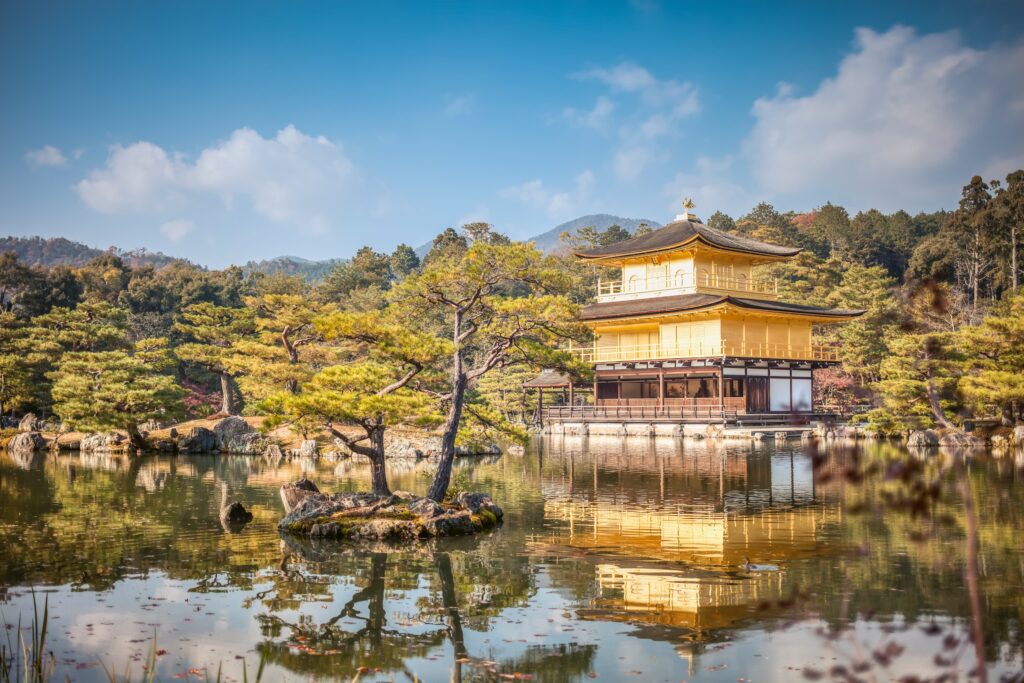
Arashiyama: Where Nature’s Beauty Meets Serenity
In the western reaches of Kyoto lies a district that seems plucked from a dream – Arashiyama. This enchanting locale is a symphony of natural wonders, cultural treasures, and timeless serenity, beckoning travelers to immerse themselves in its beauty. Whether wandering through the towering bamboo grove, gliding down the Hozu River, or exploring the UNESCO World Heritage Site, Tenryu-ji Temple, Arashiyama, offers an unforgettable experience emblematic of Kyoto’s allure.
The Bamboo Grove’s Silent Majesty
Arashiyama’s most renowned feature is its bamboo forest, a sight that transports visitors into a world of wonder. As you step into the grove, the towering bamboo shoots seem to touch the heavens, casting dappled sunlight on the earth below. Walking through this serene sanctuary, the rustling of the bamboo leaves in the wind creates a gentle, soothing symphony. It’s no wonder this grove is a favorite among photographers and nature enthusiasts.
A River’s Tranquil Journey
The Hozu River, meandering through Arashiyama, offers another facet of natural beauty. Visitors can embark on a boat ride down the river, where the serene waters carry them through a landscape of lush greenery and scenic vistas. The journey is a visual delight and a meditative experience that allows you to connect with the tranquil heart of Arashiyama.
Tenryu-ji Temple: A UNESCO Gem
Nestled within Arashiyama is Tenryu-ji Temple, a UNESCO World Heritage Site and one of Kyoto’s most treasured landmarks. The temple’s name, which translates to “Temple of the Heavenly Dragon,” hints at its spiritual significance. Its exquisite Zen gardens, serene ponds, and historic architecture create an atmosphere of profound tranquility. The temple’s main hall offers panoramic views of the surrounding landscape, including the iconic bamboo grove.
A Culinary and Shopping Haven
Beyond its natural and cultural wonders, Arashiyama boasts a wealth of shops and restaurants that invite you to savor the flavors of Kyoto. Sample traditional Kyoto cuisine, browse for unique souvenirs, or stroll the charming streets. It’s a place where every corner reveals a bit of Kyoto’s rich heritage.
Beyond Arashiyama
While Arashiyama is a destination in its own right, Kyoto has much more to offer for those with an adventurous spirit. Kyoto’s tapestry is rich and diverse, from the historic streets of Gion to the serene moss gardens of Saiho-ji Temple and the vibrant festivals that paint the city with color. These three locations – Shinjuku Gyoen National Garden, Omoide Yokocho, and Shinjuku Sanchome – provide an excellent starting point for first-time visitors. Still, they are just the beginning of a captivating journey through Kyoto’s timeless charm. So, let Arashiyama’s beauty be your prelude to Kyoto’s enchanting story, and savor every moment of this city’s timeless allure.

Hiroshima’s Top Places to Visit in Japan
Welcome to Hiroshima, a city that has risen from the ashes of history to become a shining example of resilience and renewal. In the western reaches of Japan’s main island, Honshu, Hiroshima has a story like no other. It’s a story of tragedy, yes, but more importantly, it’s a story of triumph over adversity, a testament to the indomitable spirit of humanity.
In 1945, Hiroshima became synonymous with the devastating power of the atomic bomb, forever marking its place in the annals of history. The memories of that day remain imprinted in our minds as a haunting reminder of the disastrous impact of nuclear war. However, what truly sets Hiroshima apart is its unique history, present, and future.
Today, Hiroshima is a city that has gracefully woven together the threads of its poignant history, its rich cultural heritage, and the breathtaking beauty of its natural surroundings. It’s a city that stands as a living memorial to those who suffered, as a beacon of hope and a fervent advocate for peace.
In this blog post, we’ll take you on a journey through Hiroshima’s top places to visit. From iconic landmarks that bear witness to its history of resilience to the vibrant cultural scene that thrives in its streets and the serene natural landscapes surrounding it, Hiroshima offers a tapestry of experiences that will leave you inspired and in awe.
Come along with us as we discover this city that embodies resilience and rejuvenation. Here, we pay homage to the past, revel in the liveliness of the present, and look forward to a future filled with opportunities for tranquility and success. Welcome to Hiroshima – a city unlike any other.
The Hiroshima Peace Memorial Park: A Beacon of Remembrance and Hope
If you’re a history enthusiast with a penchant for exploring places that resonate with profound significance, the Hiroshima Peace Memorial Park should undoubtedly top your list of must-visit destinations. Situated in the heart of Hiroshima, this park is not just a historical site; it’s a testament to the enduring human pursuit of peace in the face of unimaginable tragedy.
Built to commemorate the victims of the atomic bombing on August 6, 1945, and to promote a world free from the specter of nuclear conflict, the Hiroshima Peace Memorial Park is today recognized as the most renowned Peace Memorial in the world. It is a powerful symbol of remembrance, reconciliation, and the collective determination to ensure such devastation never repeats.
At the heart of the park, you’ll find the iconic Atomic Bomb Dome, a UNESCO World Heritage Site that remains one of the most enduring and poignant symbols of the bombing’s destructive power. This skeletal structure, miraculously preserved amidst the devastation, is a haunting reminder of the cataclysmic events that unfolded on that fateful day.
Adjacent to the Atomic Bomb Dome lies the Peace Memorial Museum, where history comes to life through captivating exhibits. The museum houses a wealth of artifacts, photographs, and personal stories that offer a sobering glimpse into Hiroshima’s past and the devastating aftermath of the atomic bomb. Visitors can gain a deeper understanding of the human toll, the resilience of survivors, and the city’s unwavering commitment to advocating for peace and nuclear disarmament.

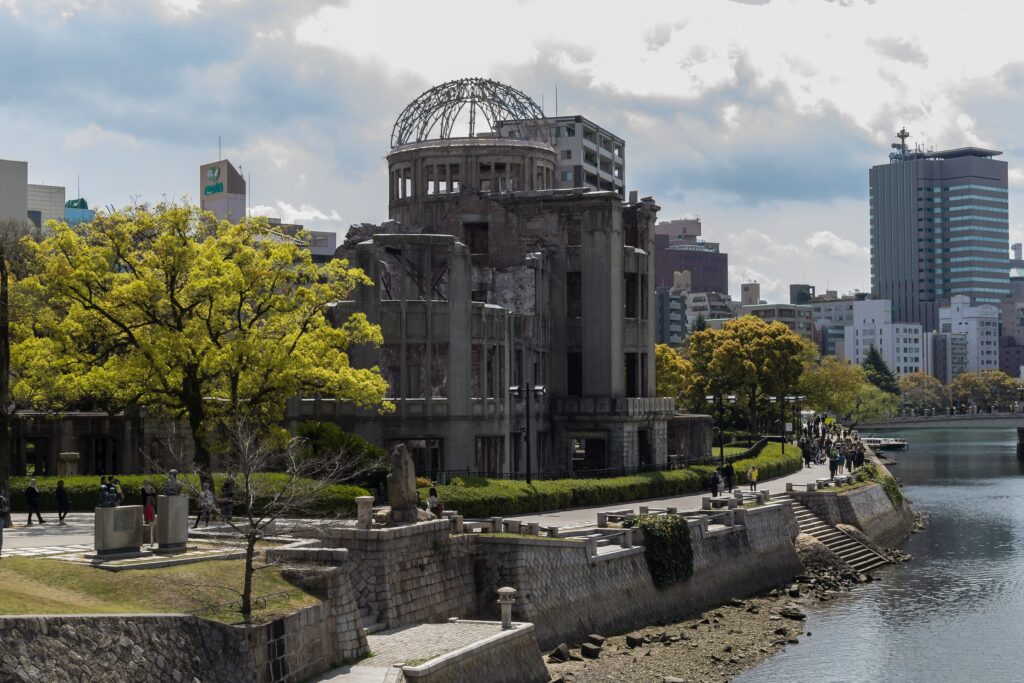
Plenty Of Monuments And Memorials Await You
As you stroll through the park, you’ll encounter various other monuments and memorials that pay homage to the victims and convey messages of hope and unity. The Children’s Peace Monument, with its origami paper cranes, is a touching tribute to the youngest victims of the bombing and a symbol of the world’s collective wish for a peaceful future.
The Hiroshima Peace Memorial Park is not merely a historical site; it’s a place where history converges with an emotional plea for peace. It symbolizes the strength, rejuvenation, and persistent aspiration for a future free from the terrors of nuclear conflict that humanity possesses.

So, whether you’re a history buff, a peace advocate, or a traveler seeking to delve into a city’s soul, visit the Hiroshima Peace Memorial Park. It’s a place that will leave an indelible mark on your heart and a profound appreciation for the resilience of the human spirit.
The Children’s Peace Monument
The Children’s Peace Monument in Hiroshima, Japan, built in dedication to the memory of the thousands of children who lost their lives during the bombing of Hiroshima on August 6, 1945, today is the world’s most famous icon that symbolizes hope and peace.
The monument features a bronze statue of a young girl named Sadako Sasaki, who was two years old when the bomb dropped. Sadako was diagnosed with leukemia as a result of the radiation exposure from the bombing, and she spent the last years of her life folding paper cranes in the hopes that doing so would grant her wish for peace and good health. She passed away at the age of 12, and her story has since become a symbol of the tragedy and hope of Hiroshima.
The statue of Sadako stands atop a pedestal adorned with thousands of paper cranes that people from all over the world folded. These cranes are a symbol of peace and a tribute to Sadako’s wish for a better world.
The monument is in the Hiroshima Peace Memorial Park, home to a museum and several other monuments dedicated to the memory of the bombing. Thousands of people visit the Children’s Peace Monument annually, including school groups, tourists, and residents who come to pay their respects and honor the memory of the children who died.
Children’s Peace Monument
In addition to its symbolic significance, the Children’s Peace Monument serves as a reminder of the terrible consequences of war and the importance of promoting peace and understanding. It is a powerful symbol of hope and a call to action for everyone everywhere to work towards a better future.
Miyajima Island’s Top Places to Visit in Japan
Located in the Seto Inland Sea, a ferry ride from Hiroshima, Miyajima Island is a hidden gem of Japan. This small island, known for its stunning natural beauty, traditional architecture, and friendly deer that roam its streets, is a place that will captivate your senses and transport you to a world of timeless charm.
As soon as you disembark from the ferry onto the shores of Miyajima, a surreal scene unfolds before you. Towering above the island’s landscape is the iconic Itsukushima Shrine, its vermilion-red torii gate seeming to float on the water during high tide, a sight so enchanting that it’s often referred to as one of Japan’s three most beautiful views.
Itsukushima Shrine is not just a testament to architectural brilliance; it’s a cultural treasure steeped in history and spirituality. This Shinto shrine has been a sacred site for more than a thousand years for worshippers and travelers. Its timeless beauty and stunning location have made it an essential stop for visitors from all around the globe.
Miyajima Island is more than just its famous shrine, though. It’s a place where tradition meets modernity in perfect harmony. As you wander the streets of the island’s small town, you’ll encounter traditional Japanese ryokans and charming shops selling local handicrafts and culinary delights. Don’t be surprised if you meet the island’s famous deer residents, known for their friendly disposition and photogenic appeal.
Discoveries Beyond Deers And Shrines Await You
The island’s natural beauty is equally captivating. Hiking enthusiasts can explore the verdant hills that offer panoramic views of the island and beyond. The ancient forest that covers a significant portion of Miyajima is a living testament to the island’s commitment to preserving its natural heritage.
And let’s not forget the culinary delights that Miyajima has to offer. Freshly grilled oysters, a local specialty, are a must-try for seafood lovers. Stroll along the streets and savor the aroma of mouthwatering street food stalls offering a variety of treats, from Momiji manju (maple leaf-shaped cakes) to savory okonomiyaki.
Miyajima Island is a captivating destination that blends nature, culture, and history. The island’s serene shrines, fascinating wildlife, and stunning landscapes create an enchanting tapestry that promises an unforgettable adventure of exploration and amazement. Miyajima Island is the perfect choice if you’re looking for a place that will leave you spellbound.
So, if you’re planning a visit to Hiroshima, set aside a day to explore the enchanting Miyajima Island. It’s a place that will enrich your travel experience and leave you with lasting memories of a destination where the past and present coexist in perfect harmony.
Itsukushima Shrine: Where the Divine Meets the Ethereal
As you step onto Miyajima Island, you’ll find yourself in a true architectural marvel and a spiritual sanctuary – the Itsukushima Shrine. This remarkable shrine, designated as a UNESCO World Heritage Site, beckons travelers from around the globe with its otherworldly beauty and the mesmerizing illusion of a “floating” torii gate.
The Itsukushima Shrine is a masterpiece of architectural ingenuity, seamlessly integrated with its natural surroundings. Its torii gate makes it truly extraordinary, which defies gravity as it appears to float on the water during high tide. This iconic vermilion-red gate is a sight that transcends the ordinary, evoking a sense of wonder and reverence that words can scarcely capture.
The shrine’s history dates back over a millennium, making it a repository of Japan’s rich cultural heritage and spiritual traditions. It’s dedicated to the Shinto goddess of the sea and storms, Benzaiten, and has long been a place of worship and pilgrimage. Visitors can explore the shrine’s intricately designed halls and witness ceremonies that connect the human spirit with the natural world.
Daisho-in Temple: A Haven of Serenity and Spiritual Discovery
Nestled amidst the serene beauty of Miyajima Island, the Daisho-in Temple is a tranquil oasis of Buddhist spirituality and cultural richness. With its profound history and array of religious artifacts, this temple offers a journey into the heart of Japanese Buddhism and a respite from the hustle and bustle of modern life.
As you enter the temple grounds, you’ll encounter a captivating array of statues, pagodas, and other religious artifacts that tell stories of devotion and enlightenment. The temple’s setting, surrounded by lush greenery and nestled in the embrace of nature, creates an atmosphere of serenity conducive to reflection and spiritual discovery.
One of the highlights of Daisho-in Temple is the pilgrimage path leading to Mount Misen’s summit, the highest peak on Miyajima Island. This ascent offers breathtaking panoramic views of the island and an opportunity for contemplation and self-discovery. Along the way, you’ll encounter stone monuments and statues inviting you to explore Buddhist philosophy’s depths.
For those seeking a deeper connection with their spiritual selves, Daisho-in Temple provides a space for meditation and introspection. The temple’s serene ambiance and the gentle rustling of leaves in the surrounding forest create an ideal environment for inner peace and mindfulness.
Miyajima Island, with Itsukushima Shrine and Daisho-in Temple as its spiritual and cultural anchors, is a destination that invites you to embark on a journey of both outer and inner exploration. It’s a place where the ethereal beauty of nature harmoniously coexists with the divine essence of these sacred sites. Whether you’re a history buff, a seeker of spiritual enlightenment, or simply a traveler searching for unique experiences, visiting Itsukushima Shrine and Daisho-in Temple will leave an indelible mark on your soul.
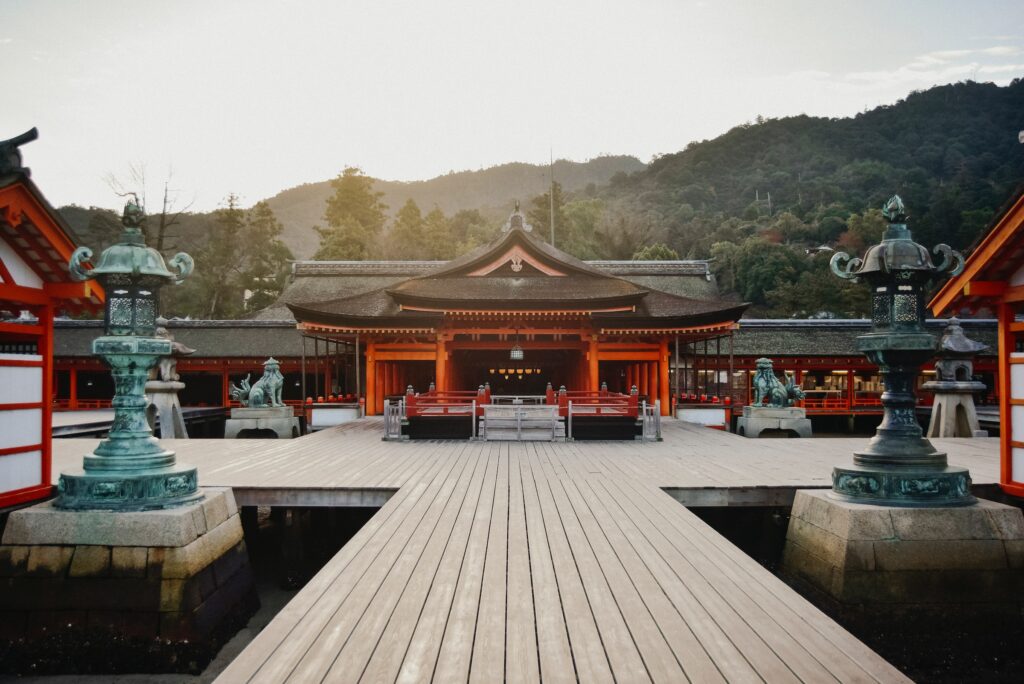
Mount Misen: A Peak Experience in Miyajima
When exploring the enchanting Miyajima Island, a journey to the summit of Mount Misen is an absolute must for nature enthusiasts and adventure seekers. Rising majestically as the island’s highest peak, Mount Misen offers breathtaking panoramic views of Miyajima and an immersive experience in the natural beauty of the Seto Inland Sea.
The Mount Misen hiking trail is a rewarding endeavor with a sense of accomplishment and stunning vistas. As you make your way up through lush woods and over rugged terrain, a serene atmosphere will surround you, transporting you far away from the commotion and noise of your day-to-day existence. The gentle rustling of leaves and birds chirping provide a soothing soundtrack to your journey.
One of the hike’s highlights is encountering the numerous stone monuments and statues that dot the trail. Each of these markers tells a story, whether it’s a testament to a pilgrim’s journey or a reflection of Buddhist philosophy. The sense of history and spirituality that permeates the mountain is a unique aspect of the Mount Misen experience.
After you reach the summit, the awe-inspiring vistas will be a well-deserved reward. The panoramic views of the island, the surrounding sea, and the distant mainland are nothing short of spectacular. Whether you visit at sunrise to witness the world bathed in the soft hues of dawn or at sunset as the sun dips below the horizon, Mount Misen offers a view that will forever remain etched in your memory.
There Is Also A Ropeway So You Can Skip The Hike
For those who prefer not to hike, a ropeway provides a comfortable and scenic route to the summit. Whether you choose to walk or take the ropeway, the experience of Mount Misen is a journey that connects you with the island’s natural beauty and provides a sense of wonder that lingers long after you’ve descended.
Indeed, with its captivating blend of history, culture, and nature, Hiroshima offers a truly unique travel experience. From the sad yet inspiring Hiroshima Peace Memorial Park to the serene beauty of Miyajima Island and the exhilarating heights of Mount Misen, this city is a must-visit destination for those seeking to immerse themselves in Japan’s past and experience its vibrant present. Hiroshima is a city that leaves an indelible mark on the hearts and minds of all who venture here, where history, culture, and nature converge to create unforgettable memories.
Osaka’s Top Places to Visit in Japan
Welcome to the captivating city of Osaka, a destination that invites you to embark on a mesmerizing journey through the diverse facets of Japanese culture, history, and modernity. Osaka stands as a beacon of energy and excitement in the heart of Japan, offering a unique blend of traditional charm and contemporary dynamism. As you step foot in this bustling metropolis, you’ll discover that Osaka is a city of contrasts, where historic landmarks coexist with bustling urban streets, serene gardens provide a tranquil escape from the city’s hustle, and cutting-edge entertainment venues cater to every taste.
Osaka’s allure lies in its ability to cater to a broad spectrum of interests. Whether you’re an avid history enthusiast, a culinary adventurer, a shopper seeking the latest trends, or a traveler yearning for cultural experiences, Osaka has something special in store for you.
In this blog post, we’ll be your tour guide through Osaka’s top places for sightseeing, uncovering the city’s many treasures and highlighting the experiences that make it an essential destination for explorers. From iconic landmarks to hidden gems, Osaka’s offerings will leave you enchanted and eager to delve into its ich tapestry of attractions.
So, get ready to immerse yourself in the essence of Osaka as we take you on a captivating journey through this remarkable city. Whether you’re a first-time visitor or a seasoned traveler, Osaka’s unique blend of old and new promises a travel experience like no other. Let’s set out on an adventure through Osaka’s top sights and prepare to be inspired by the heart and soul of Japan’s “Kitchen of the Nation.”
Universal Studios Japan: Where Imagination Comes to Life
Nestled in the vibrant city of Osaka, Universal Studios Japan (USJ) is a world-class theme park that ignites the imagination and promises a day of unforgettable entertainment. With millions of visitors flocking to its gates each year, USJ has rightfully earned its place as one of Japan’s premier attractions. This dynamic park celebrates all things cinematic, bringing beloved movies and TV shows to life through a dazzling array of rides, concerts, and attractions.
The Wizarding World of Harry Potter
Step into the enchanting world of J.K. Rowling’s beloved wizarding series as you enter The Wizarding World of Harry Potter. This meticulously crafted section of the park transports you to the hallowed halls of Hogwarts School of Witchcraft and Wizardry, complete with iconic landmarks like the Hogwarts Castle and Hogsmeade Village. You can embark on thrilling adventures such as the Forbidden Journey ride and sip on butterbeer at the Three Broomsticks, making it a must-visit for Potterheads.
Jurassic Park

Get ready for a journey back in time to the era of dinosaurs at Jurassic Park. The spine-tingling Jurassic Park – The Ride takes you on a waterborne adventure through a prehistoric world filled with life-sized dinosaurs. It’s an exhilarating experience that combines thrills with a dash of scientific wonder.
Spider-Man
Swing into action with one of Marvel’s most iconic superheroes in the Spider-Man attraction. This 4D ride puts you right in the heart of the action as you join Spider-Man in his quest to save the city from villains. The stunning visuals and immersive storytelling make it a favorite among visitors of all ages.
A Whole World Of Experieces Await You
Beyond these marquee attractions, USJ offers a wide range of experiences, from thrilling roller coasters to captivating live shows featuring beloved characters. The park’s commitment to detail and its dedication to providing an immersive experience ensure that every corner holds a surprise, whether you’re exploring the whimsical world of Minions or joining the action-packed battle in Transformers: The Ride.
Universal Studios Japan is not just a theme park; it’s a place where imagination and reality converge to create magical moments for visitors of all ages. It’s a destination where you can relive your favorite movie moments, experience the thrill of cinematic adventures, and create memories that will last a lifetime. So, whether you’re a film buff, an adrenaline junkie, or simply seeking a day of fun and wonder, Universal Studios Japan promises an extraordinary journey into entertainment. Join us as we explore the magic of USJ and all the delights it has to offer.
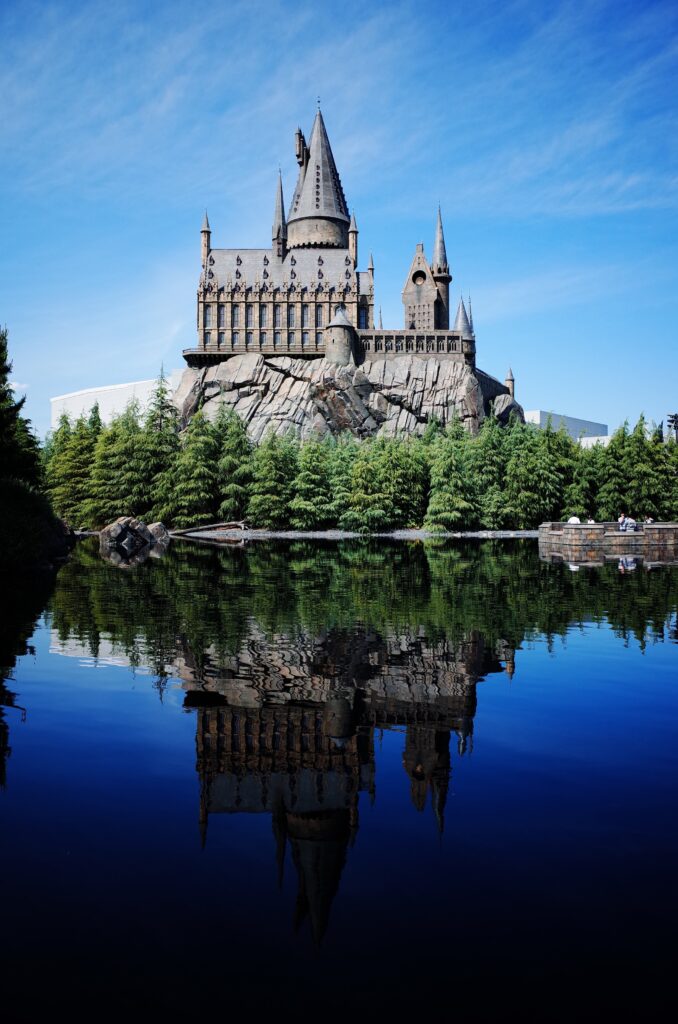



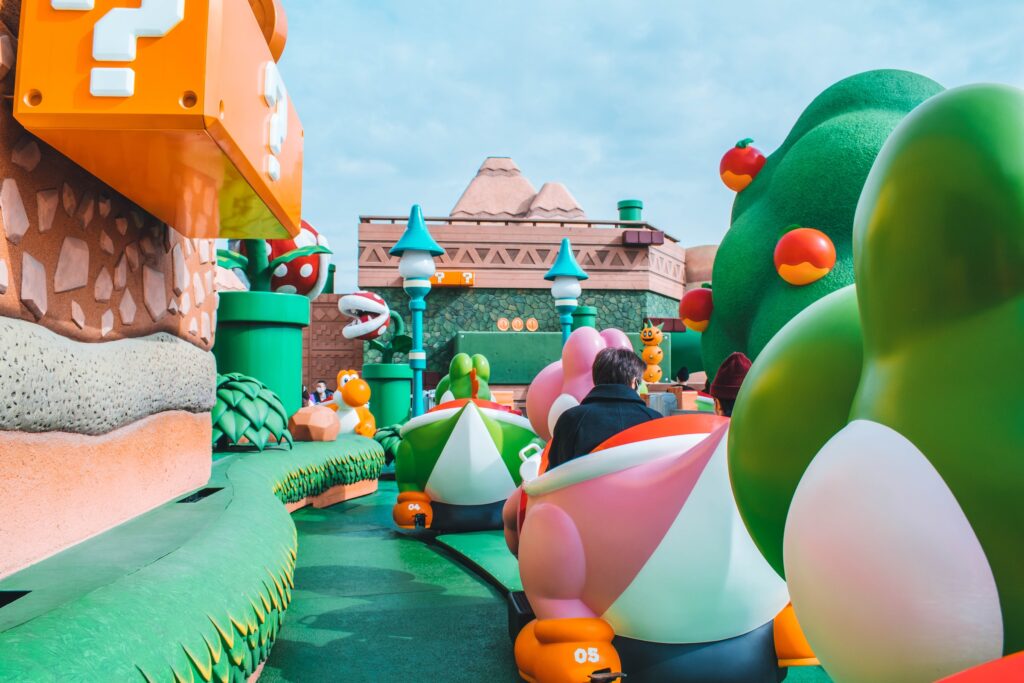
Dotonbori: Osaka’s Epicenter of Entertainment and Gastronomy
In the heart of Osaka, where tradition meets modernity, you’ll find the vibrant and iconic district of Dotonbori. This bustling entertainment hub is a testament to Osaka’s spirited and lively atmosphere, drawing locals and visitors into its dazzling embrace. With its bright lights, flashy signs, and a culinary scene that will tantalize your taste buds, Dotonbori is a must-visit destination for anyone seeking an authentic Japanese experience.
Illuminated Nightscape: As the sun sets, Dotonbori comes to life in a dazzling display of neon lights and vibrant billboards. The district’s iconic Glico Running Man sign, a neon runner crossing the finish line, serves as a beacon that welcomes travelers into this electric wonderland. Strolling along the canal’s edge, you’ll find yourself surrounded by a kaleidoscope of colors and an ambiance that is uniquely Dotonbori.

Culinary Delights: Dotonbori is a culinary paradise where you can embark on a gastronomic adventure like no other. Here, street food reigns supreme, and the choices are endless. Be sure to try takoyaki, a beloved local delicacy featuring savory octopus balls smothered in delectable sauces. Okonomiyaki, Japanese-style delicious pancakes, are also a must-try, allowing you to customize your toppings to your heart’s content. And don’t forget kushikatsu, deep-fried skewers that offer an explosion of flavors with each bite. The aroma of these mouthwatering dishes wafts through the air, guiding you to countless street vendors and restaurants.
Entertainment Extravaganza: Beyond its culinary delights, Dotonbori is a hub for entertainment. The district boasts many restaurants, bars, and nightclubs, making it a perfect place to experience Osaka’s vibrant nightlife. Whether you’re in the mood for karaoke, live music, or dancing the night away, Dotonbori has something for everyone.
Shinsaibashi Shopping Arcade
Adjacent to Dotonbori is the Shinsaibashi Shopping Arcade, a sprawling retail paradise where you can indulge in some retail therapy. From high-end boutiques to quirky shops selling unique souvenirs, Shinsaibashi offers a diverse shopping experience.
Dotonbori is not just a place; it’s an experience, a sensory journey through the heart of Osaka’s culture and lifestyle. Whether you’re an epicurean explorer or a nightlife enthusiast, Dotonbori’s energy and charm will captivate you. So, join us as we delve into the vibrant world of Dotonbori, where bright lights, mouthwatering cuisine, and unforgettable memories await.
Overall, Osaka is a great city to visit if you want a fun and exciting experience in Japan. With its great food, shopping, and entertainment, it is sure to be a highlight of your trip.
Hokkaido: Japan’s Northern Gem of Natural Splendor and Culinary Delights
Nestled at the northernmost tip of Japan’s archipelago lies the enchanting island of Hokkaido. This pristine and expansive land is a testament to Japan’s breathtaking natural beauty, where lush landscapes, dramatic coastlines, and towering mountains coexist harmoniously. Beyond its stunning views, Hokkaido boasts a wealth of culinary gems, thrilling outdoor activities, and captivating cultural encounters, making it a must-visit destination.
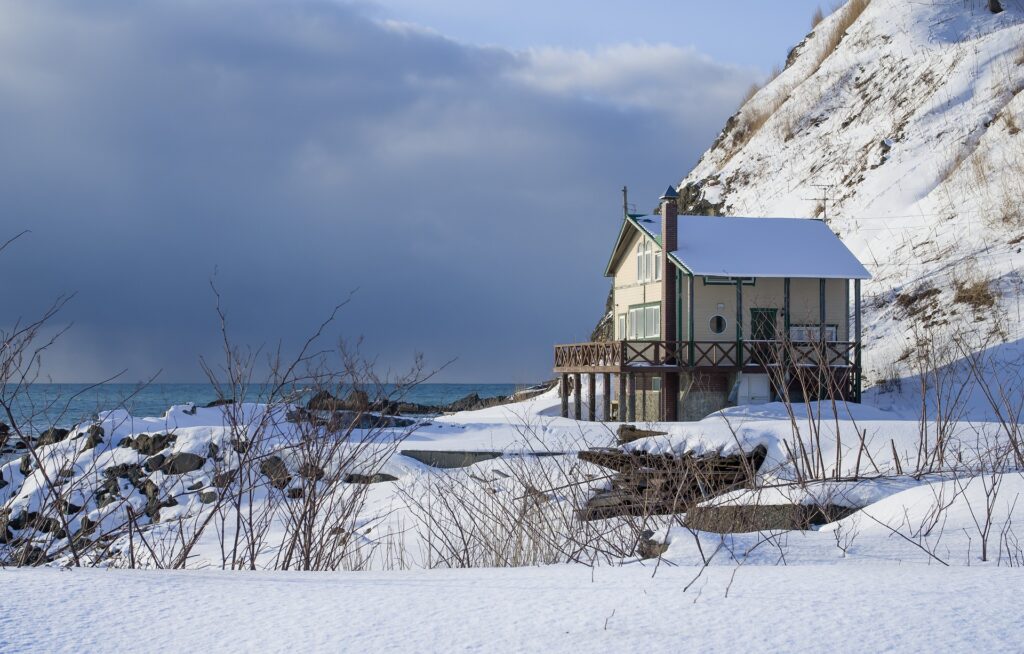
Natural Beauty
Hokkaido’s landscape is a canvas painted with nature’s finest hues. From the mesmerizing lavender fields of Furano to the pristine shores of the Shakotan Peninsula, Hokkaido offers a feast for the eyes every season. The island is a playground for outdoor enthusiasts, with hiking trails, hot springs, and national parks like Shiretoko and Daisetsuzan, where you can witness untouched wilderness and diverse wildlife.
Winter Wonderland
Hokkaido transforms into a winter wonderland when snow blankets the region. The island is renowned for its world-class ski resorts, making it a paradise for winter sports enthusiasts. Places like Niseko and Sapporo’s nearby mountains offer powder snow and exhilarating slopes, attracting skiers and snowboarders from around the globe.
Culinary Delights
Hokkaido is a gastronomic haven celebrated for its fresh seafood, dairy products, and delectable desserts. The island’s cold waters yield some of Japan’s finest seafood, including succulent crab, sweet scallops, and melt-in-your-mouth sushi. Be sure to savor Hokkaido’s famous dairy treats like creamy ice cream, buttery biscuits, and rich cheeses made from the island’s high-quality milk.
Cultural Experiences
Beyond its natural and culinary wonders, Hokkaido offers a glimpse into the traditional Ainu culture of the island’s indigenous people. Discovering the rich cultural heritage of different communities is possible by visiting museums and cultural centers. These places offer a glimpse into their unique traditions and customs through exhibitions of art, music, and various rituals.
Festivals and Events
Hokkaido hosts numerous festivals and events year-round, including the Sapporo Snow Festival, where intricate ice sculptures take center stage, and the vibrant Yosakoi Soran Festival, a celebration of dance and music that embodies Hokkaido’s lively spirit.
Onsen Retreats
Hokkaido boasts numerous natural hot springs, also known as onsen, that offer a serene and revitalizing experience. The mineral-infused waters, complemented by awe-inspiring sceneries, provide the perfect setting to unwind and recharge. Places like Noboribetsu and Jozankei are renowned for their therapeutic baths.
Hokkaido offers much more than just an island experience. It presents a vibrant tapestry of unforgettable encounters that will enrich your journey. Whether you gravitate towards nature, adventure, culinary delights, or cultural experiences, Hokkaido has something to offer everyone. This diverse and captivating adventure will leave you with a deep appreciation for Japan’s northern treasure. So, join us as we explore Hokkaido’s wonders, from its snow-covered peaks to its sun-drenched fields, and savor the flavors and experiences that make this island a destination.

Sapporo Snow Festival: A Winter Wonderland of Art and Celebration
Every February, Sapporo, Hokkaido’s capital city, transforms into a magical winter wonderland that draws visitors worldwide. The Sapporo Snow Festival, one of Japan’s most iconic events, is a breathtaking celebration of snow and ice, where art, culture, and camaraderie converge to create an unforgettable experience.
Gigantic Snow Sculptures
The centerpiece of the Sapporo Snow Festival is undoubtedly its enormous snow sculptures. The sculptures, standing tall like frozen giants, require months of careful planning and skillful craftsmanship to come to life, with designs ranging from iconic landmarks to famous characters from pop culture, showcasing an astonishing level of detail and artistry. Strolling through the festival grounds, you’ll find yourself surrounded by these towering works of art, each a testament to human creativity and the wonder of winter.
Ice Sculptures
Besides the snow sculptures, the festival features stunning ice sculptures that glisten in the winter sunlight. These intricate creations, crafted by talented artists, capture the fleeting beauty of ice and light, creating a dazzling spectacle that captivates visitors of all ages.

Interactive Displays
The Sapporo Snow Festival offers more than just visual splendor. Many of the sculptures and installations are interactive, allowing visitors to engage with the artwork and participate in various winter-themed activities. From ice slides that promise a thrilling descent to snow mazes that challenge your navigational skills, there’s no shortage of fun and excitement.
Culinary Delights
As you roam around the festival, an alluring variety of food vendors will welcome you with hot beverages and substantial winter delicacies. Warm up with hot cocoa or indulge in local Hokkaido specialties like grilled seafood and savory hot pot dishes. The aroma of sizzling treats and the cozy outdoor dining atmosphere add to the festival’s charm.
Cultural Performances
The Sapporo Snow Festival is not just about sculptures and food; it also celebrates culture. Visitors can enjoy a variety of cultural performances, including traditional Japanese music and dance, adding a rich layer of heritage to the festivities.
Illuminated Evenings
The festival takes on a different enchantment as the sun sets. The beautifully decorated sculptures cast a soft glow across the snow-covered landscape. It’s a magical time to explore the festival grounds and capture stunning photos of the illuminated art.
The Sapporo Snow Festival is a testament to the indomitable spirit of winter and human creativity. It’s a celebration of the beauty found in the coldest months of the year and a reminder that art and culture can flourish even in the harshest conditions. Whether you’re an art lover, a winter sports enthusiast, or simply looking for a unique and unforgettable experience, the Sapporo Snow Festival promises a journey into a world of wonder and imagination where the magic of winter comes to life. So, bundle up, sip on some hot cocoa, and join us as we explore this snowy spectacle that captures the hearts of millions each year.
Shikotsu-Toya National Park: Nature’s Masterpiece in Hokkaido
Nestled in the southwestern reaches of Hokkaido, Shikotsu-Toya National Park stands as a testament to the untamed beauty of nature. This enchanting natural wonderland is home to two stunning caldera lakes, Lake Toya and Lake Shikotsu, each offering a picturesque backdrop for a wide range of outdoor adventures and relaxation. Whether you’re a nature enthusiast, an adventure seeker, or a traveler searching for serene landscapes, Shikotsu-Toya National Park beckons with its diverse charms.

Caldera Lakes
The park’s crown jewels, Lake Toya and Lake Shikotsu, are nestled within the calderas of ancient volcanoes, creating landscapes of unparalleled splendor. With its crystal-clear waters, Lake Toya is a haven for water sports enthusiasts. Visitors can enjoy boating, fishing, and lakeside picnics while taking in the breathtaking views of the surrounding mountains. Lake Shikotsu, known for its pristine waters, offers kayaking and stand-up paddleboarding opportunities. Both lakes are ideal for leisurely walks along their shores and capturing stunning photographs.
Hiking Trails
Shikotsu-Toya National Park is a paradise for hikers and nature lovers. The park boasts scenic trails that wind through lush forests, past waterfalls, and viewpoints that offer panoramic vistas of the lakes and surrounding mountains. Whether you’re a seasoned trekker or a casual hiker, the park’s trails cater to all levels of outdoor enthusiasts.
Hot Springs and Onsens
As Hokkaido is renowned for its hot springs, it’s no surprise that Shikotsu-Toya National Park boasts several onsens (hot spring resorts) where visitors can relax and rejuvenate. Imagine soaking in the soothing, mineral-rich waters of a natural hot spring while surrounded by the serene beauty of the park. It’s a genuinely therapeutic experience that allows you to connect with nature and unwind.
Seasonal Activities
Shikotsu-Toya National Park offers a plethora of activities year-round. In the winter, the park becomes a playground for skiers and snowboarders, with nearby resorts providing ample opportunities for winter sports. As the snow blankets the landscape, it creates a serene ambiance perfect for snowshoeing and cross-country skiing. The park’s lush greenery comes alive in the summer, inviting visitors to explore its trails and enjoy the region’s pleasant climate.
Shikotsu-Toya National Park is a natural gem that showcases Hokkaido’s rugged beauty and diverse offerings. It’s a place where you can immerse yourself in the tranquility of nature, embark on thrilling adventures, or simply find solace in the soothing embrace of hot springs. Whether you are seeking outdoor excitement or a serene escape, Shikotsu-Toya National Park welcomes you with open arms, promising an unforgettable journey through its pristine landscapes and rejuvenating waters. Join us as we explore this exquisite corner of Hokkaido, where nature reigns supreme and the allure of the great outdoors awaits at every turn.

Overall, Hokkaido is a must-visit destination in Japan for nature lovers, foodies, and winter sports enthusiasts.
Nara: Where Tradition and Nature Converge
Nestled in the picturesque Kansai region of Japan lies the historic city of Nara, where the echoes of Japan’s rich cultural heritage resound amidst stunning natural beauty. Nara’s allure lies in its harmonious blend of tradition and nature, offering a captivating tapestry of experiences that leave a lasting impression on all who visit.

Historical Significance
Nara is the country’s first permanent capital in Japanese history, established in 710 AD. As such, it boasts a treasure trove of cultural and historical landmarks. Among them, Nara Park, home to hundreds of free-roaming deer and the iconic Todai-ji Temple, is a UNESCO World Heritage Site that captures the essence of Nara’s historical significance.
Seasonal Delights
The shifting seasons enhance Nara’s natural beauty, each presenting a unique picturesque landscape. Spring brings a pink spectacle as cherry blossoms blanket the city, while autumn transforms the foliage into a golden paradise. Celebrating these seasonal transitions through festivals is a testament to Nara’s rich cultural heritage.
Culinary Delights
Nara’s culinary scene is a delightful journey of flavors, from local specialties like kakinoha sushi (persimmon leaf sushi) to savory street food. As you explore Nara’s streets, savoring its delectable offerings, you’ll find its cuisine as diverse and rich as its cultural heritage.
Nara is more than a city; it’s a living testament to Japan’s enduring traditions and the breathtaking beauty of its natural surroundings. It’s a place where you can stroll through history, commune with nature, and savor the essence of Japanese culture. Suppose you are interested in ancient temples, peaceful gardens, or the delightful company of Nara’s amiable deer. This city guarantees an adventure of exploration and amazement, where the past and present blend together effortlessly. So, join us as we explore Nara, a city that invites you to step back in time and immerse yourself in its timeless charm.
Todai-ji Temple: Home to Japan’s Colossal Buddha and Cultural Treasures
In the heart of Nara, Japan, stands a monumental testament to ancient craftsmanship and spiritual devotion – the Todai-ji Temple. This revered site, a UNESCO World Heritage Site and one of Japan’s most iconic temples, is steeped in history and cultural significance. As one draws near to its revered premises, a sense of wonderment envelops them, as it has done for countless travelers throughout the ages.
The Great Buddha (Daibutsu)
At the heart of Todai-ji Temple stands an extraordinary feat of artistry and engineering – the Great Buddha. This colossal bronze statue, towering over 15 meters in height and weighing approximately 500 tons, is a breathtaking representation of Buddhist ideals. The Great Buddha symbolizes enlightenment and inner peace, and visitors worldwide come to stand in its awe-inspiring presence. The sheer scale and intricate details of the statue are a testament to the skill and devotion of the artisans of ancient Japan.
Nandaimon Gate
our journey to the Great Buddha begins at the Nandaimon Gate, a massive wooden structure guarded by two fierce-looking statues known as Nio. These guardians symbolize protection against evil spirits and serve as a formidable introduction to the temple complex. Passing through this gate, you step onto a path that leads to the heart of Todai-ji.
The Great South Gate
The Great South Gate is a magnificent structure that denotes a feeling of awe and respect, marking the southern entrance of the temple. It is a portal to the spiritual world, inviting visitors to explore the temple’s inner sanctum.
Hall of the Great Vow
Within the temple complex, you’ll find the Hall of the Great Vow, a magnificent wooden structure that houses the Great Buddha. As soon as you enter the hall, tranquility and amazement will wash over you. The expansive interior of the hall is a remarkable area that enables you to fully admire the magnitude and creativity of the statue from a close distance.
Cultural Treasures
While the Great Buddha is the highlight of Todai-ji, the temple also houses a wealth of other cultural treasures. Intricate sculptures, ancient artifacts, and religious relics can be found throughout the temple grounds, offering a deeper understanding of Japan’s rich cultural heritage.
Todai-ji Temple is not just a historical monument; it’s a place of spiritual significance and artistic brilliance. It invites you to contemplate the profound teachings of Buddhism, marvel at the ingenuity of ancient builders, and appreciate the enduring cultural legacy of Japan. A visit to this sacred site is a journey into the heart of Japan’s spiritual and artistic heritage, where the past meets the present in a timeless expression of human achievement. As you explore Todai-ji Temple, you’ll find that its grandeur and cultural significance continue to inspire and captivate visitors from all walks of life.
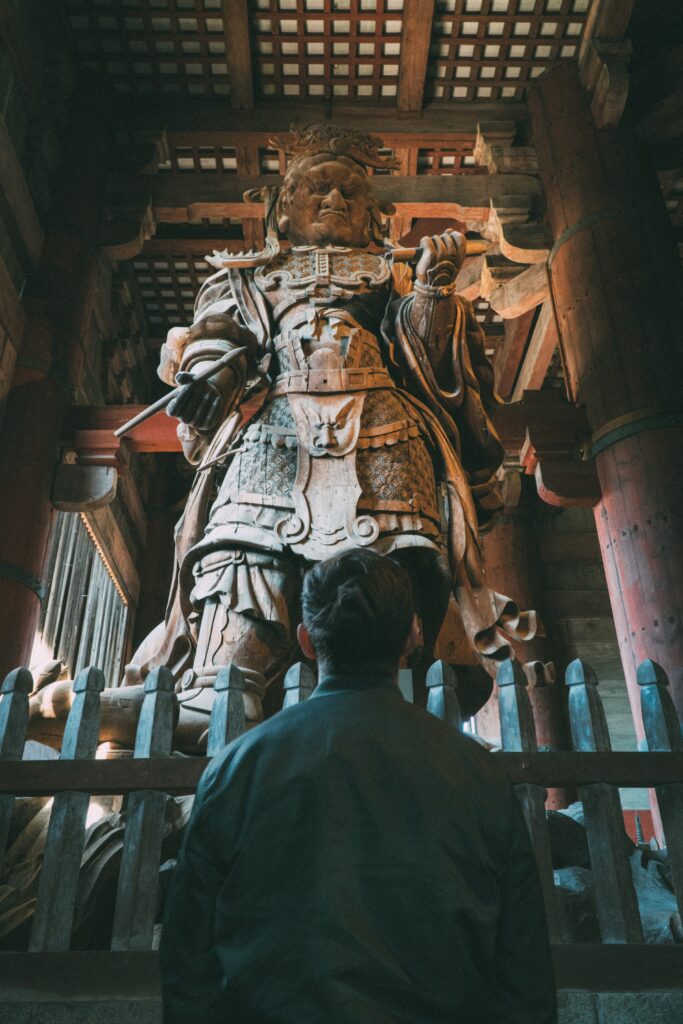
Nara Park: Where Nature, History, and Serenity Converge
Nara Park, nestled in the heart of Nara, is a captivating oasis where nature and history intertwine to create a serene and culturally rich experience. This expansive public park, known for its tranquil beauty and iconic deer population, offers visitors a unique opportunity to connect with the natural world and Japan’s rich cultural heritage.
Deer Sanctuary
Nara Park is perhaps best known for its cherished residents – over 1,000 wild Sika deer that roam freely throughout the park. These graceful creatures are considered a national treasure and symbol of Nara’s cultural heritage. Visitors can interact with the deer, feed them special “shika senbei” crackers, and capture memorable moments as they peacefully graze amidst the park’s lush landscapes.

Cultural Landmarks
Beyond the enchanting deer, Nara Park is home to some of Japan’s most iconic cultural landmarks. The Kasuga-Taisha Shrine, beautiful lantern-lined paths leading to its sacred grounds, provides a tranquil setting for reflection and exploration. The Kofuku-ji Temple, a historic Buddhist temple, offers visitors a glimpse into Japan’s spiritual legacy with its towering pagoda and serene gardens.
Natural Beauty
The park’s natural beauty is a testament to the harmony between humanity and nature. Cherry blossoms in spring transform the garden into a sea of delicate pink petals, creating an idyllic backdrop for picnics and leisurely walks. In autumn, vibrant foliage paints the park in shades of red and gold, inviting visitors to revel in the season’s colors.
Scenic Strolls
Nara Park’s walking paths wind through picturesque landscapes, past tranquil ponds, and under canopies of ancient trees. Strolling through these serene surroundings, visitors can find moments of peace and contemplation, far removed from the bustle of modern life.
Historical Significance
The park’s proximity to several of Nara’s renowned temples and shrines allows for a seamless exploration of Japan’s rich history and cultural heritage. Visitors can easily extend their journey by visiting the nearby Todai-ji Temple and other architectural marvels that date back centuries.
Nara Park is a sanctuary of natural beauty, cultural significance, and tranquil serenity. It embodies the essence of Japan’s reverence for nature and its deep-rooted traditions. Whether you come to admire the deer, explore the historical landmarks, or simply savor the tranquility of the park’s surroundings, a visit to Nara Park promises a journey of discovery and rejuvenation. So, join us as we explore this exceptional sanctuary, where the gentle presence of deer, the whispers of history, and the beauty of nature converge to create an unforgettable experience.
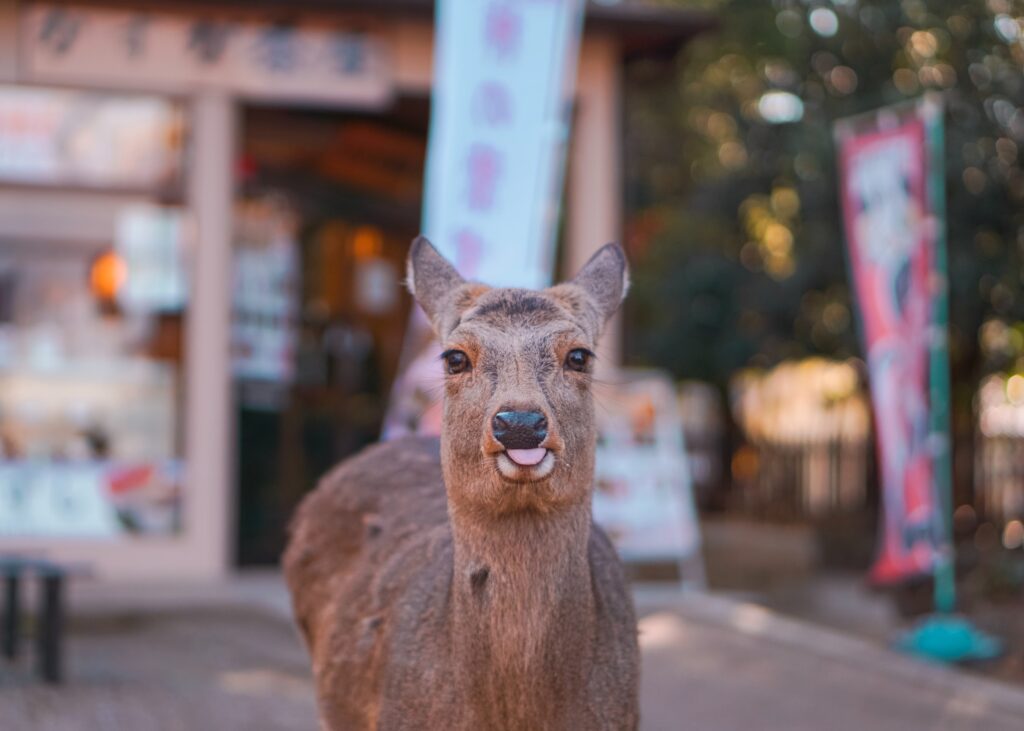

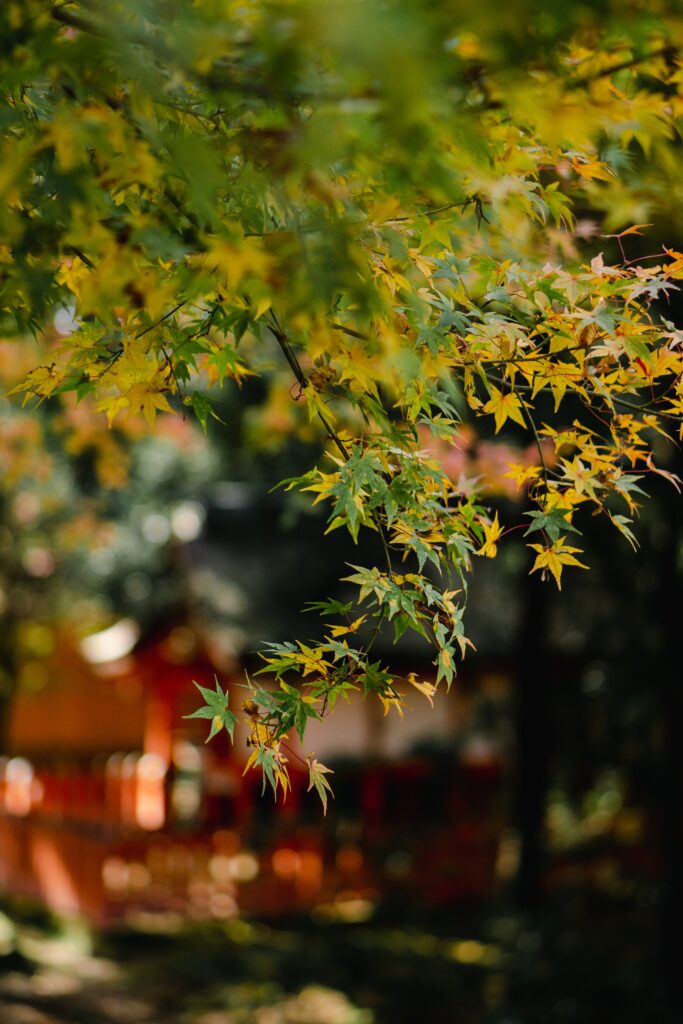
Overall, Nara is an excellent destination for anyone interested in Japanese culture and history and those who love nature and wildlife. Add Todai-ji Temple and Nara Park to your itinerary when visiting this beautiful city.
Kanazawa: Where Time Stands Still in Edo-Era Splendor
Nestled in the picturesque Ishikawa Prefecture of Japan lies the enchanting city of Kanazawa, where history unfolds amidst the backdrop of stunning traditional gardens, historic buildings, and impeccably preserved Edo-era districts. Kanazawa is a treasure trove of cultural heritage and natural beauty, inviting visitors to step back in time and experience the charm of old Japan.
Edo-Era Districts
Kanazawa is renowned for its exceptionally well-preserved Edo-era districts, where the spirit of ancient Japan comes to life. Walking around areas such as Higashi-Chaya and Kazue-Machi will take you back to a time long gone. These historical neighborhoods have wooden teahouses, meandering narrow streets, and a thriving traditional geisha culture.

Historical Geisha Culture
Kanazawa has a deep connection to the world of geisha, and visitors can delve into this captivating culture at designated geisha districts like Higashi-Chaya. Traditional tea ceremonies, dance performances, and the opportunity to interact with geisha are all part of the experience.
Nagamachi Samurai District
Another window into Kanazawa’s history is the Nagamachi Samurai District, where samurai once resided. Here, you can explore well-preserved samurai residences and gain insights into the lives of these ancient warriors.
Gold Leaf Craftsmanship
Kanazawa is famous for its gold leaf production, and visitors can witness the intricate art of gold leaf application at local workshops. You can even try your hand at creating your gold leaf souvenir.
Culinary Delights
Kanazawa’s culinary scene reflects its rich heritage. The city is renowned for its seafood, including delectable sushi and fresh seafood bowls. Don’t miss the opportunity to savor Kaga cuisine, a regional specialty that celebrates the flavors of Ishikawa.
Contemporary Art
Alongside its historical attractions, Kanazawa embraces modernity with its contemporary art scene. The 21st Century Museum of Contemporary Art, Kanazawa, features cutting-edge exhibitions and innovative artworks that contrast the city’s traditional charm.
Kanazawa is more than a city; it’s a living testament to Japan’s cultural legacy and a place where time stands still in Edo-era splendor. Explore the captivating city of Kanazawa, where art, history, and nature converge to create an unforgettable experience. Whether you’re a lover of the arts, a history enthusiast, or simply seeking a peaceful retreat in a traditional Japanese garden, Kanazawa has something for everyone. Discover the seamless integration of the past and present as you immerse yourself in the city’s timeless beauty and cultural treasures. Join us on this journey of wonder and discovery in Kanazawa.
Exploring the Enchanting Beauty of Kenroku-en Garden in Kanazawa
Regarding traditional Japanese garden design, few places can rival the timeless beauty of Kenroku-en Garden. Nestled in the heart of Kanazawa, Ishikawa Prefecture, Kenroku-en is often hailed as one of Japan’s three most beautiful gardens, standing proudly alongside Kairaku-en in Mito and Koraku-en in Okayama. Join us on a virtual journey through this exquisite garden, where every season brings a unique charm.
A Garden with a Storied Past
Kenroku-en’s history dates back to the Edo period when it was lovingly crafted over generations by the Maeda clan, rulers of the Kaga Domain. This historical significance lends an air of antiquity to the garden, making it not just a place of natural beauty but also a living testament to Japan’s rich cultural heritage.
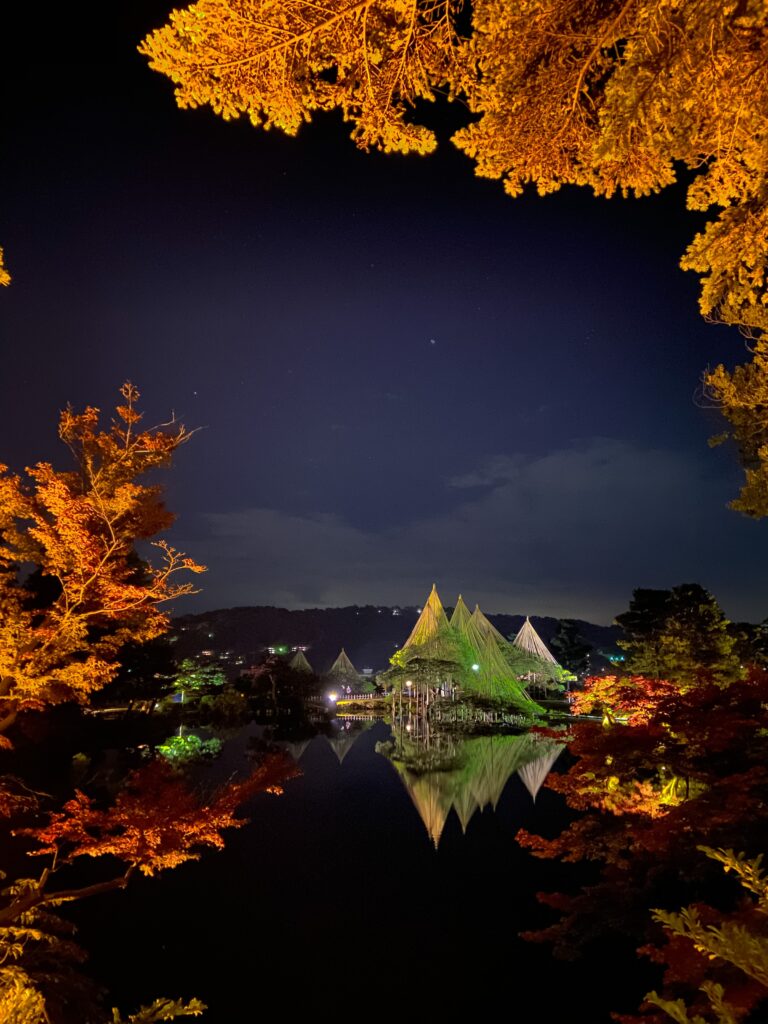
Design Philosophy: The Six Principles of Perfection
At the heart of Kenroku-en’s allure is adherence to the six principles of a perfect Japanese garden, known as “rokaku” or “roku-jin-ju.” These principles include spaciousness, seclusion, artificiality, antiquity, abundant water, and expansive views. As you wander through the garden’s carefully designed landscapes, you’ll appreciate the meticulous balance between nature and human craftsmanship.
A Serene Landscape: Key Features
Kenroku-en boasts a captivating array of features that invite exploration:
- Ponds: The garden features several ponds, such as Kasumiga-ike, Hisago-ike, and Neagari-no-ike, connected by meandering streams and adorned with charming stone bridges.
- Teahouses: Within the garden, you’ll discover traditional teahouses where you can partake in the serene Japanese tea ceremony, sipping matcha tea and savoring seasonal Japanese sweets.
- Walking Paths: Kenroku-en’s well-maintained walking paths allow you to immerse yourself in its changing scenery, revealing new wonders at every turn.
- Islands: Some of the garden’s ponds are home to tiny islands graced with pruned trees and carefully chosen plants, enhancing the garden’s visual appeal.
Seasonal Magic: A Garden for All Seasons
Kenroku-en enchants visitors year-round:
- Spring: Witness the garden burst into life during cherry blossom season (sakura), inviting picnickers for hanami (flower viewing) under a canopy of pink and white blooms.
- Autumn: Fall ushers in a breathtaking transformation as the maple trees paint the landscape in vibrant reds and oranges.
- Winter: Experience the garden’s unique winter charm, where snow blankets the landscape, and the traditional yukitsuri (snow-supporting ropes) create a captivating winter scene.
Kanazawa Castle: A Historic Neighbor
Kenroku-en is conveniently located opposite Kanazawa Castle, offering the opportunity to explore both attractions in one visit. Kanazawa Castle is steeped in history and provides a striking contrast to the garden’s natural serenity.
Cultural Experiences and Visitor Facilities
In Kenroku-en, you can immerse yourself in Japanese tea culture by participating in traditional tea ceremonies at the garden’s teahouses. The park also hosts seasonal events and festivals that showcase local traditions and arts. Rest areas, souvenir shops, and multilingual information signs ensure visitors have a comfortable and enriching experience.
Plan Your Visit
Kenroku-en Garden welcomes visitors year-round, with varying hours of operation depending on the season. Admission fees apply, with special rates for children and seniors. Whether you’re a nature enthusiast, a cultural explorer, or simply seeking a tranquil escape, Kenroku-en offers everyone a slice of Japanese paradise.
Join us on a journey through the captivating beauty of Kenroku-en Garden, where nature and tradition intertwine in perfect harmony. Uncover why this garden is renowned as one of Japan’s most exquisite treasures and add it to your list of must-see places on your upcoming journey in Kanazawa.
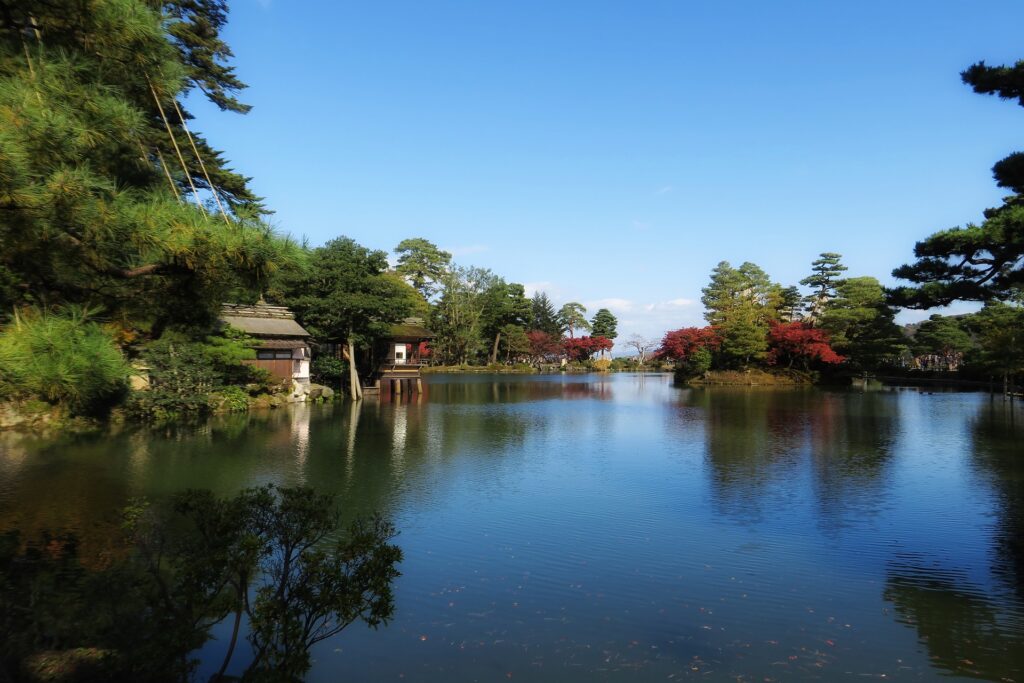
Unveiling the Rich History of Kanazawa Castle: A Stalwart of Japanese Heritage
Nestled in the heart of Kanazawa, known for its rich cultural heritage, Kanazawa Castle is an enduring testament to Japan’s history. This historic castle, dating back to 1583, has witnessed centuries of change and transformation, playing a pivotal role in the region’s history. Join us on a journey as we explore the captivating story of Kanazawa Castle.
A Seat of Power: The Maeda Clan’s Legacy
Kanazawa Castle was a grand architectural marvel and the epicenter of power during the Edo period. It served as the stronghold of the mighty Maeda clan, who ruled over the Kaga Domain. This clan, renowned for its wealth and influence, played a significant role in shaping the region’s destiny.
A Phoenix Rising from the Ashes: Reconstruction After Fire
In 1759, tragedy struck when a devastating fire consumed the castle, leaving it in ruins. However, the indomitable spirit of the people prevailed, and Kanazawa Castle was rebuilt in 1788. The reconstruction effort breathed new life into the historic fortress, preserving its legacy for generations.
Exploring the Castle Grounds: A Journey through Time
Today, visitors to Kanazawa Castle can explore its historic grounds. As soon as you enter the castle gates, you will feel transported to a bygone era of chivalrous samurai and influential feudal lords. Get ready to discover a captivating world brimming with fascinating history and awe-inspiring marvels.
- Restored Turrets: The castle’s meticulously restored turrets, complete with their traditional architectural details, offer a glimpse into the grandeur of the past. They provide an excellent vantage point to take in panoramic views of the city.
- Gates: Ornate gates that once served as symbols of authority and protection still stand proudly, inviting you to pass through and delve deeper into the castle’s history.
- Walls: The sturdy stone walls, withstood the test of time, tell the tales of battles and sieges that shaped the region’s history.
Immerse Yourself in History
Visiting Kanazawa Castle is not just a journey through time; it’s an opportunity to immerse yourself in the rich tapestry of Japan’s history. The castle grounds provide a serene and contemplative space where you can reflect on the stories of the past while enjoying the picturesque surroundings.
Plan Your Visit
Kanazawa Castle is a testament to the enduring spirit of Japan and its commitment to preserving its heritage. Visitors are welcome to explore the castle grounds, and admission fees may apply. Don’t miss the chance to explore this iconic landmark while discovering the cultural treasures of Kanazawa.
As you traverse the castle grounds and gaze upon its restored turrets, gates, and walls, you’ll come to appreciate the enduring legacy of Kanazawa Castle, a living monument to the history and heritage of this remarkable city.

Exploring Nikko: Japan’s Hidden Gem of History and Nature
Nestled amidst the tranquil mountains of Tochigi Prefecture, Japan, lies the enchanting town of Nikko. While it may be small, Nikko’s rich history, natural splendor, and cultural significance have earned it a special place in the hearts of travelers. Join us as we embark on a virtual tour of this remarkable destination.
A Tapestry of History: UNESCO World Heritage Sites
Nikko is a treasure trove of UNESCO World Heritage Sites, each with its own story to tell:
- Toshogu Shrine: The crowning jewel of Nikko’s heritage, the Toshogu Shrine is the final resting place of Tokugawa Ieyasu, the founder of the Tokugawa shogunate. Its intricate architecture and detailed wood carvings are a testament to the craftsmanship of the Edo period. Be prepared to be awe-struck by the grandeur of this shrine.
- Taiyuinbyo Shrine: Nestled in serene surroundings, Taiyuinbyo Shrine serves as the mausoleum for Tokugawa Iemitsu, the third Tokugawa shogun. It offers a more contemplative and tranquil experience compared to Toshogu Shrine.
- Futarasan Shrine: Nestled amid the verdant foliage of Nikko, the Futarasan Shrine pays homage to the divine spirits of the surrounding mountains. It is an idyllic sanctuary where the tranquility of nature blends seamlessly with the soulful spirituality of the shrine.
Autumn’s Radiance: A Symphony of Colors
Nikko is perhaps most famous for its stunning autumn foliage. As the leaves transform into brilliant shades of red, orange, and gold, the town becomes a captivating canvas of color—visitors from across Japan and worldwide flock to Nikko to witness this natural spectacle. One can relish the colorful foliage by taking a scenic hike or leisurely walking through the charming town’s streets and parks.
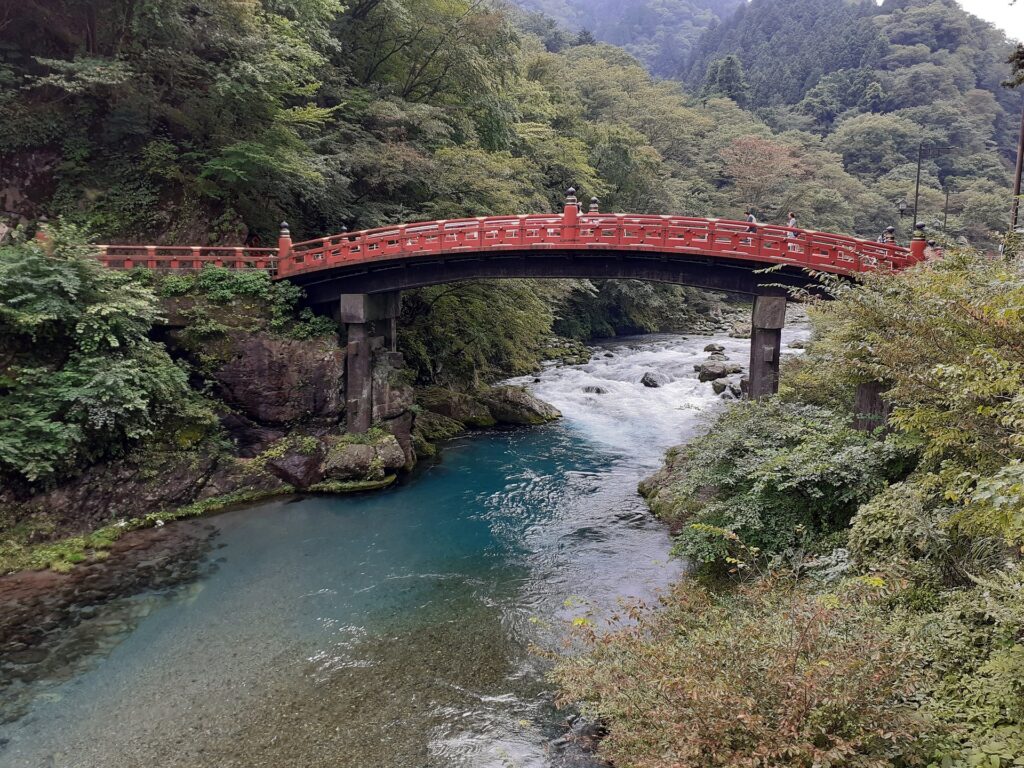
Convenient Day Trips from Tokyo
One of the remarkable aspects of Nikko is its accessibility. Located just a few hours away from Tokyo by train, it’s the perfect destination for a day trip. Tokyoites often escape to Nikko to immerse themselves in its serene atmosphere, explore its cultural treasures, and bask in the beauty of nature.
Plan Your Nikko Adventure
When planning your visit to Nikko, consider the following:
- Timing: Autumn is the peak season for foliage, but Nikko’s charm extends throughout the year, offering a unique experience each season.
- Accommodation: If you wish to extend your stay, Nikko offers a range of accommodations, from traditional ryokans to modern hotels.
- Cuisine: Don’t miss the opportunity to savor Nikko’s local specialties, including yuba (tofu skin) dishes and Manju (sweet buns).
- Exploration: Apart from the UNESCO sites, Nikko has a plethora of hiking trails, hot springs, and obscure treasures that are worth exploring.
As you explore the UNESCO World Heritage Sites, revel in the autumn splendor, and immerse yourself in Nikko’s cultural and natural wonders, you’ll appreciate why this small mountain town holds such a special place in Japan’s cultural tapestry. Whether a day trip or an extended visit, Nikko promises an unforgettable journey through history and nature.
Toshogu Shrine: A Gilded Masterpiece in the Heart of Nikko
Nikko’s cultural heritage is highlighted by the magnificent Toshogu Shrine, which exemplifies Japan’s rich history. This lavish shrine complex, nestled amidst the lush landscapes of Nikko, stands as a testament to the luxury and artistry of its era. Join us as we embark on a virtual pilgrimage to explore the wonders of Toshogu Shrine.
A Glimpse into History: Tokugawa Ieyasu’s Mausoleum
The Toshogu Shrine holds excellent significance beyond its purpose as a place of worship. It serves as the final resting place of Tokugawa Ieyasu, the visionary who founded the Tokugawa shogunate. The grand mausoleum is adorned with intricate wood carvings and lavish layers of gold leaf, creating a truly breathtaking sight that will leave a lasting impression.
A Feast for the Eyes: Artistry Beyond Compare
An astonishing array of artistic marvels greets visitors to Toshogu Shrine:
- “See No Evil, Hear No Evil, Speak No Evil” Monkeys: One of the shrine’s most iconic features is the trio of wise monkeys, each embodying the proverbial wisdom of “See no evil, hear no evil, speak no evil.” These whimsical carvings captivate the imagination of all who behold them.
- Yomeimon Gate: Prepare to be mesmerized by the glorious Yomeimon Gate, a work of art that defies description. The intricate carvings on the gate highlight various aspects of Japanese mythology, history, and culture.
Timing is Everything: Beat the Crowds
To fully savor the beauty and tranquility of Toshogu Shrine, planning your visit in the morning is advisable. If you arrive early, you’ll have the chance to fully enjoy the peaceful atmosphere of the shrine before the crowds begin to show up. This way, you can make the most of your visit without feeling overwhelmed by the number of people around you.
Prepare for Your Visit
Here are some tips to make the most of your visit to Toshogu Shrine:
- Entrance Fee: Visiting the shrine is an entrance fee, which helps support its preservation and maintenance.
- Appropriate Attire: Visitors must dress modestly to show respect for the Toshogu Shrine.
- Photography: While photography is allowed in most areas, respecting any posted restrictions is essential to preserve the shrine’s heritage.
- Exploration: Don’t rush your visit; take your time to explore the intricate details and hidden treasures scattered throughout the shrine complex.
A Journey Through Time
Toshogu Shrine is not just a monument to the past; it’s a living testament to Japan’s enduring cultural legacy. Immerse yourself in the exquisite artwork and unwavering dedication of the past as you stroll through the revered halls and view the magnificent carvings.
Whether you’re an art enthusiast, a history buff, or simply a seeker of beauty, Toshogu Shrine promises an unforgettable experience. It’s a place where the past comes alive, art and history merge, and where the spirit of Tokugawa Ieyasu continues to inspire all who visit.
Lake Chuzenji: Nature’s Jewel Above Nikko
Nestled high in the mountains above Nikko, Lake Chuzenji beckons with its serene beauty and captivating natural wonders. This picturesque lake, born from the volcanic eruption of Mount Nantai, offers visitors a tranquil escape into the heart of nature. Join us as we embark on a virtual voyage to discover the allure of Lake Chuzenji and its surrounding splendor.
A Geological Masterpiece: The Origin of Lake Chuzenji
Lake Chuzenji owes its existence to the dramatic eruption of Mount Nantai, a majestic stratovolcano that presides over the region. The explosion centuries ago created a basin that would become the serene, cobalt-blue lake we see today. This geological wonder is the stage for a wealth of natural beauty and outdoor adventures.
Boating on the Crystal Waters: A Glimpse of Tranquility
One of the most popular ways to experience the enchantment of Lake Chuzenji is by taking a boat ride. As you gracefully move across the tranquil waters, the awe-inspiring beauty of the towering mountains will surround you. The lake’s mirror-like surface reflects the lush greenery, creating a sense of calm and reflection.
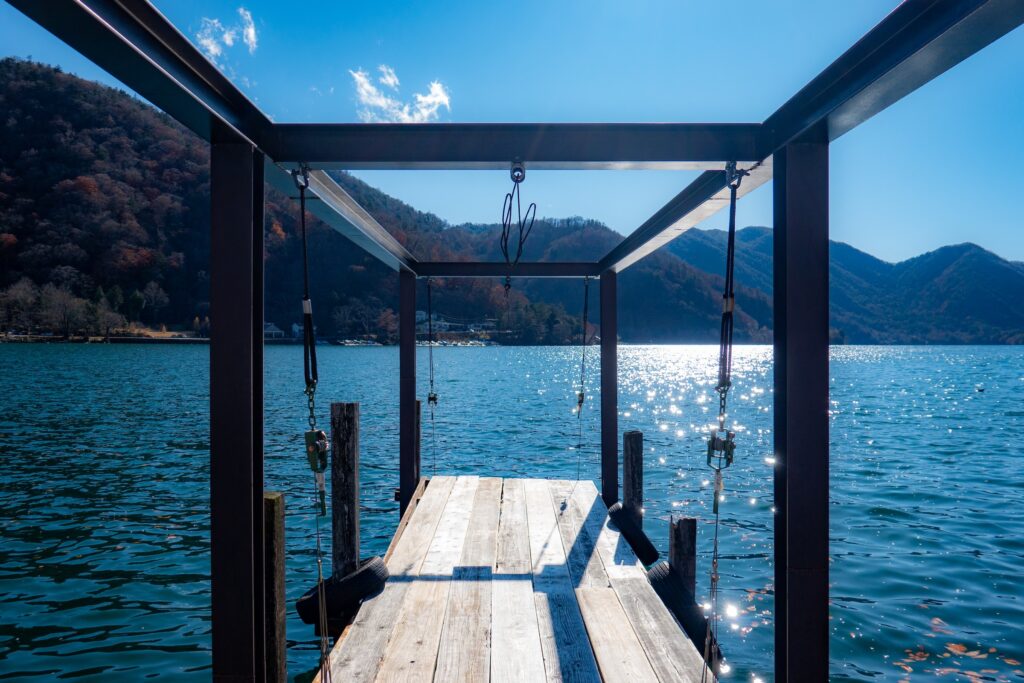
Hiking Adventures: Waterfalls and Hot Springs
For those seeking a more active exploration, the Lake Chuzenji area offers a network of hiking trails that wind through the pristine wilderness. Along the way, you’ll encounter a plethora of natural wonders:
- Waterfalls: Lake Chuzenji is renowned for its waterfalls, each with its charm. Kegon Falls, in particular, is a must-see. Plummeting dramatically from a height of 97 meters, it’s one of Japan’s most impressive waterfalls.
- Hot Springs: The area surrounding the lake is rich in hot springs (onsen). After a day of hiking, soothe your senses with a dip in one of the rejuvenating onsen, surrounded by the beauty of nature.
Savor the Seasons: A Year-Round Delight
Lake Chuzenji’s beauty knows no seasonal bounds:
- Spring: Cherry blossoms bloom along the lakeshore, infusing the area with delicate shades of pink.
- Summer: The lake becomes a calm oasis, offering respite from the summer heat.
- Autumn: The surrounding forests erupt in a riot of fiery colors, making fall the peak season for visitors.
- Winter: Blanketed in snow, the area transforms into a serene wonderland, attracting those seeking the tranquility of a winter escape.
Planning Your Visit
Here are some practical tips for your Lake Chuzenji adventure:
- Access: Lake Chuzenji is easily reached from Nikko by bus. The journey is scenic, with winding mountain roads offering glimpses of the stunning landscape.
- Boat Tours: Several operators offer boat tours on the lake, providing a guided perspective of the area’s natural beauty.
- Hiking Trails: Being well-prepared is essential if you intend to go hiking. Make sure you have the right clothes, shoes, and trail map.
- Cultural Respect: When visiting hot springs or engaging in outdoor activities, respect the natural environment and local customs.
An Immersive Journey into Nature
Lake Chuzenji is more than a picturesque lake; it’s an invitation to reconnect with the tranquility and majesty of nature. As you explore its waters, hike its trails, and bask in its seasonal transformations, you’ll discover the timeless magic of this hidden gem above Nikko. Lake Chuzenji is where the soul finds solace and the spirit refreshes—a true treasure in Japan’s natural landscape.
Hakone: Where Nature and Wellness Converge in Japan’s Mountainous Gem
Nestled in the embrace of the Kanagawa prefecture’s mountains, Hakone emerges as a captivating destination, drawing travelers from far and wide. This picturesque town is renowned for its breathtaking natural beauty and the therapeutic allure of its hot springs. Join us as we embark on a virtual journey to Hakone, where serenity and relaxation reign supreme.
Nature’s Masterpiece: Hakone’s Mountainous Majesty
Hakone’s defining feature is its stunning mountainous terrain. Towering peaks, dense forests, and pristine lakes create a captivating landscape that beckons adventurers and nature enthusiasts. Hakone is blessed with natural beauty as it is located in the Fuji-Hakone-Izu National Park, showcasing every nook and cranny of its surroundings.
Hot Springs Heaven: A Soothing Escape
Perhaps the most celebrated aspect of Hakone is its abundant hot springs, known as “onsen” in Japanese. For centuries, people have treasured these revitalizing thermal baths for their remarkable ability to heal the body and promote relaxation. When visiting Hakone, indulging in an onsen experience is a must. The soothing waters, often rich in minerals, offer a blissful escape from the stresses of daily life.
Scenic Delights: A Feast for the Senses
Hakone offers a medley of scenic delights:
- Lake Ashi: This pristine lake, nestled at the foot of Mount Fuji, provides a stunning backdrop for boat rides and lakeside strolls. On a clear day, the reflection of Mount Fuji on the lake’s surface is a sight to behold.
- Hakone Open-Air Museum: Art enthusiasts will appreciate this open-air museum, featuring an extensive collection of sculptures against Hakone’s natural beauty.
- Hakone Shrine: Perched along the shores of Lake Ashi, this Shinto shrine adds a touch of spirituality to the region’s charm.
Adventures Abound: A Haven for Explorers
Hakone caters to adventurers with a penchant for exploration:
- Hiking Trails: Explore picturesque pathways that guide you to breathtaking vistas, cascading waterfalls, and undiscovered treasures.
- Hakone Ropeway: Soar above the treetops in a cable car, granting you stunning vistas of the surrounding mountains.
- Hakone Pirate Ship: Board a replica pirate ship for a unique voyage across Lake Ashi, evoking a sense of adventure and nostalgia.
Planning Your Hakone Escape
Here are some practical tips for your journey to Hakone:
- Access: Hakone is conveniently accessible from Tokyo by train and bus. Consider purchasing a Hakone Free Pass for ease of transportation within the region.
- Accommodation: Hakone offers a variety of lodging options, including traditional ryokans (inns) that provide an authentic Japanese experience.
- Cultural Respect: Observe local customs and etiquette when enjoying onsen or visiting cultural sites.
A Journey of Renewal
With its blend of natural beauty and wellness offerings, Hakone is a sanctuary for those seeking respite from the hustle and bustle of daily life. It’s a place where you can immerse yourself in the soothing embrace of hot springs, relish the grandeur of mountain landscapes, and create lasting memories amidst Japan’s serene splendor. Whether you’re an adventurer or a seeker of tranquility, Hakone promises an unforgettable experience that rejuvenates both body and soul.
Art in Nature’s Embrace: Exploring the Hakone Open-Air Museum
Nestled in the picturesque town of Hakone, the Hakone Open-Air Museum stands as a testament to the harmonious union of art and nature. This extraordinary museum invites visitors to immerse themselves in the captivating world of outdoor sculptures set against the backdrop of the region’s majestic mountains. Join us as we embark on a virtual journey to discover the unique wonders of this open-air haven for art lovers.
A Gallery in the Great Outdoors: Sculptures Amidst Nature
The Hakone Open-Air Museum is a canvas where art comes to life in the open air. Here, you can stroll through beautifully landscaped gardens, each adorned with various sculptures. The sculptures, ranging from modern to contemporary, seamlessly integrate with the natural environment, creating a mesmerizing interplay between art and nature.
Indoor Artistry: Galleries of Inspiration
In addition to the outdoor sculptures, the museum boasts indoor galleries that house an ever-changing selection of art exhibitions. These galleries contrast the open-air displays, allowing visitors to explore a wide range of artistic expressions.
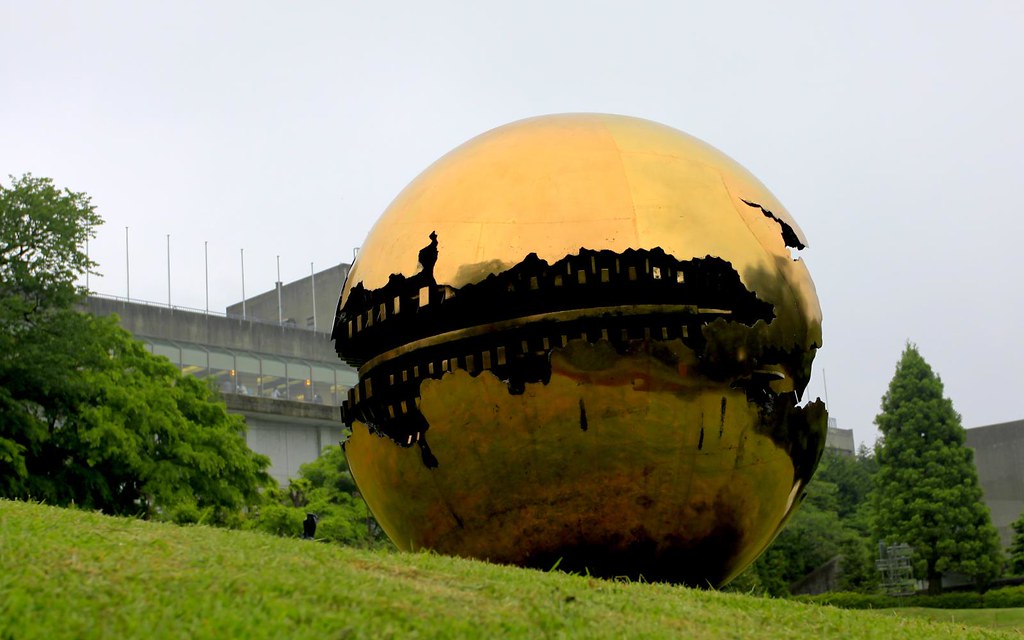
A Year-Round Retreat: Nature’s Artistic Palette
The Hakone Open-Air Museum welcomes visitors year-round, each season adding its unique charm to the experience. Spring brings cherry blossoms, summer offers lush greenery, autumn dazzles with vibrant foliage, and winter transforms the landscape into a serene wonderland.
A Place for Art Lovers: Nurturing Creativity
For art enthusiasts, the Hakone Open-Air Museum is a sanctuary. It fosters an environment where creativity and inspiration flow freely. The ability to appreciate art in such a serene and natural setting is a rare and cherished experience.
Practical Information for Your Visit
Here are some practical tips for planning your visit to the Hakone Open-Air Museum:
- Accessibility: The museum is easily accessible by train and bus from Tokyo and other major cities in Japan. The Hakone Free Pass often includes transportation to the museum.
- Operating Hours: The museum typically opens in the morning and closes late afternoon. Check the official website for current hours and any special exhibitions.
- Admission: There is an admission fee, which may vary depending on age and any special exhibitions.
- Art Appreciation: Take your time to explore the outdoor sculptures and indoor galleries. Consider joining guided tours or workshops if available.
- Cultural Etiquette: While visiting indoor galleries,
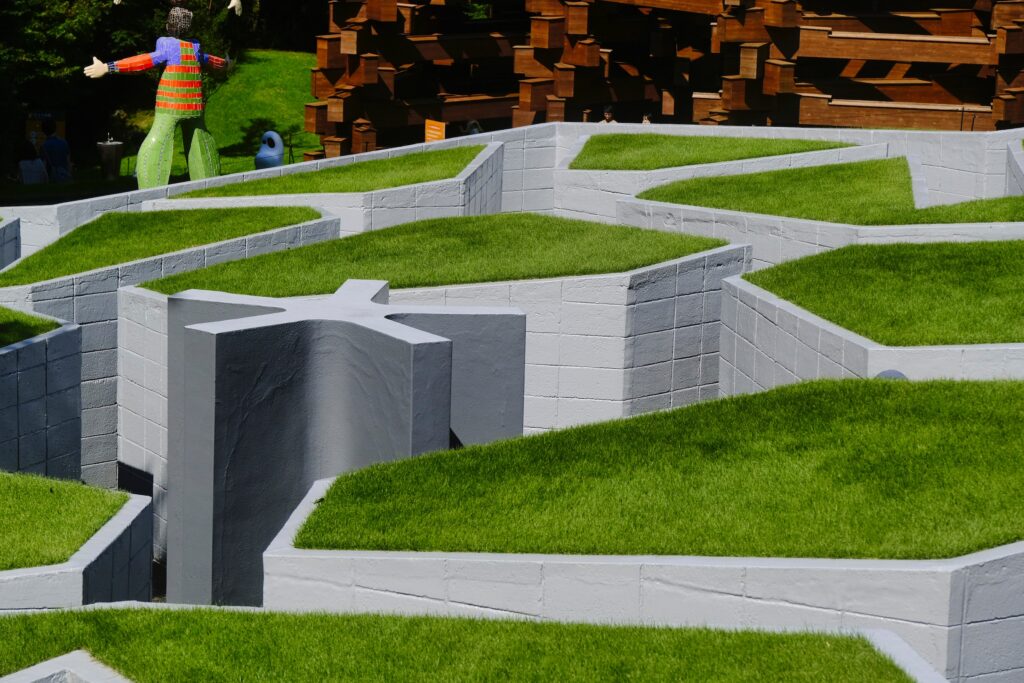

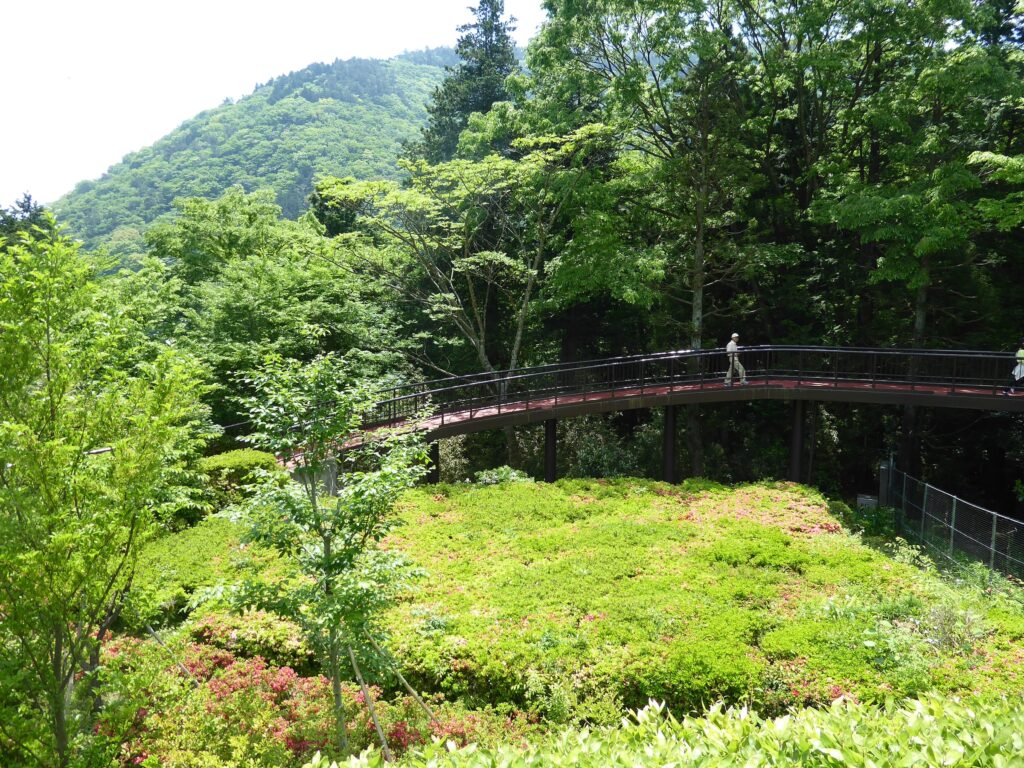
Lake Ashi: A Tranquil Oasis with Majestic Views of Mount Fuji
Nestled amidst the stunning landscapes of Japan’s Kanagawa Prefecture, Lake Ashi, also known as Ashinoko, emerges as a tranquil gem that captivates visitors with its breathtaking vistas. This scenic lake offers more than just a visual feast; it is a gateway to outdoor adventures, relaxation, and a connection with nature that is both serene and invigorating.
Mount Fuji’s Enchanted Mirror: Nature’s Masterpiece
Lake Ashi is renowned for its breathtaking views of the iconic Mount Fuji. On clear days, the majestic peak is mirrored in the lake’s still waters, creating a surreal and captivating scene that leaves an indelible mark on all who behold it. This spectacle alone makes Lake Ashi a must-visit destination for travelers worldwide.
Boating Adventures: Navigating the Serenity
One of the best ways to soak in the tranquil ambiance of Lake Ashi is by taking a boat tour. As you gracefully move across the calm waters, the breathtaking mountains encompassing you will leave you in awe. The boat tours offer the perfect opportunity to appreciate the captivating views of Mount Fuji while basking in the gentle embrace of the lake’s tranquility.
Hiking Trails: A Journey into Nature’s Heart
Lake Ashi and its surroundings offer an extensive network of hiking trails for those who prefer to be closer to the earth. These trails wind through lush forests, offering glimpses of hidden waterfalls and serene spots where you can commune with nature. Whether you’re an avid hiker or a casual stroller, there’s a trail to suit your pace and preferences.
Hot Springs and Japanese Inns: A Relaxation Haven
Lake Ashi is also famous for its proximity to hot springs (onsen) and traditional Japanese inns (ryokan). After a day of exploration, immerse yourself in the soothing waters of an onsen, where the healing properties of the thermal baths will rejuvenate your body and spirit. A stay at a ryokan allows you to savor traditional Japanese hospitality and cuisine while gazing upon the lake’s serene beauty.
Practical Tips for Your Visit
Here are some practical considerations when planning your Lake Ashi adventure:
- Access: Lake Ashi is easily accessible by train, bus, or car from Tokyo. Consider using the Hakone Free Pass for convenient transportation within the Hakone region.
- Boat Tours: Boat tours are available throughout the day, but it’s advisable to check the schedule in advance and arrive early during peak seasons.
- Hiking: Wear comfortable clothing and footwear suitable for hiking if you plan to explore the trails around the lake.
- Onsen Etiquette: Familiarize yourself with onsen etiquette, which often includes bathing in the nude and adhering to specific customs.
A Journey of Serenity and Majesty
Lake Ashi is more than a picturesque lake; it’s an invitation to reconnect with the beauty of nature and the majesty of Mount Fuji. Whether you’re seeking adventure, relaxation, or a moment of quiet contemplation, Lake Ashi offers a sanctuary where the soul finds solace and the spirit soars. It’s a place where the wonders of the natural world harmonize with the tranquility of human nature, creating an experience that lingers in your heart and memory long after you’ve departed.
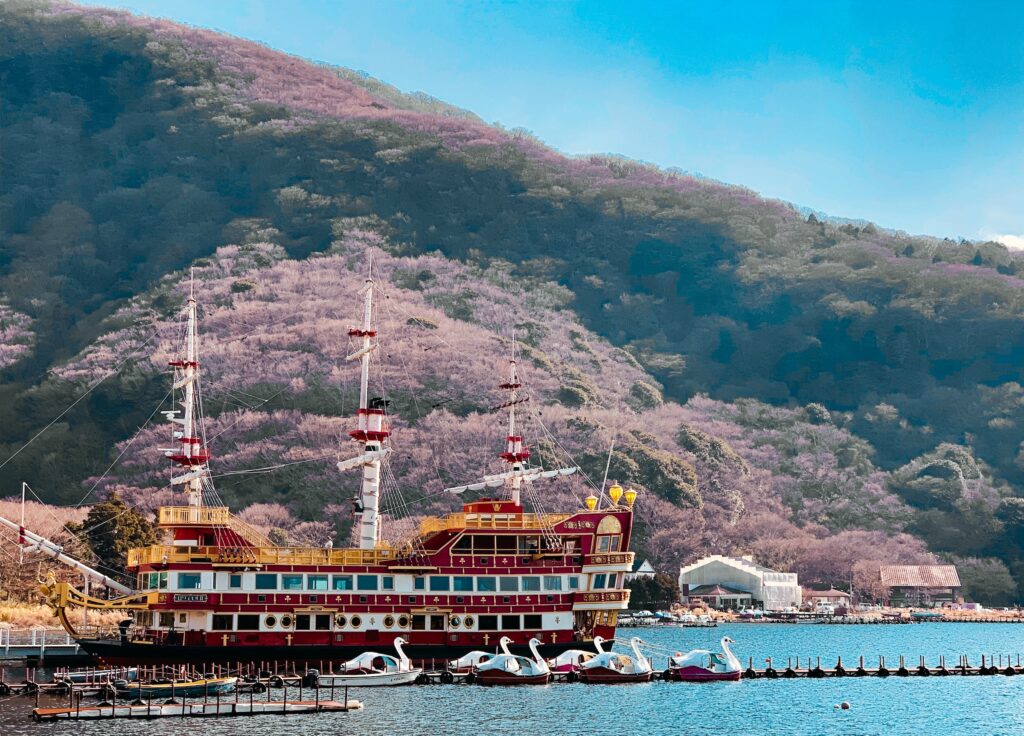
Himeji’s Top Places to Visit in Japan
Himeji is a city located in Hyogo Prefecture, Japan. It is known for its beautiful Himeji Castle, one of Japan’s few original castles that have survived wars, earthquakes, and other natural disasters. The castle is a UNESCO World Heritage Site and is considered one of Japan’s most beautiful castles.
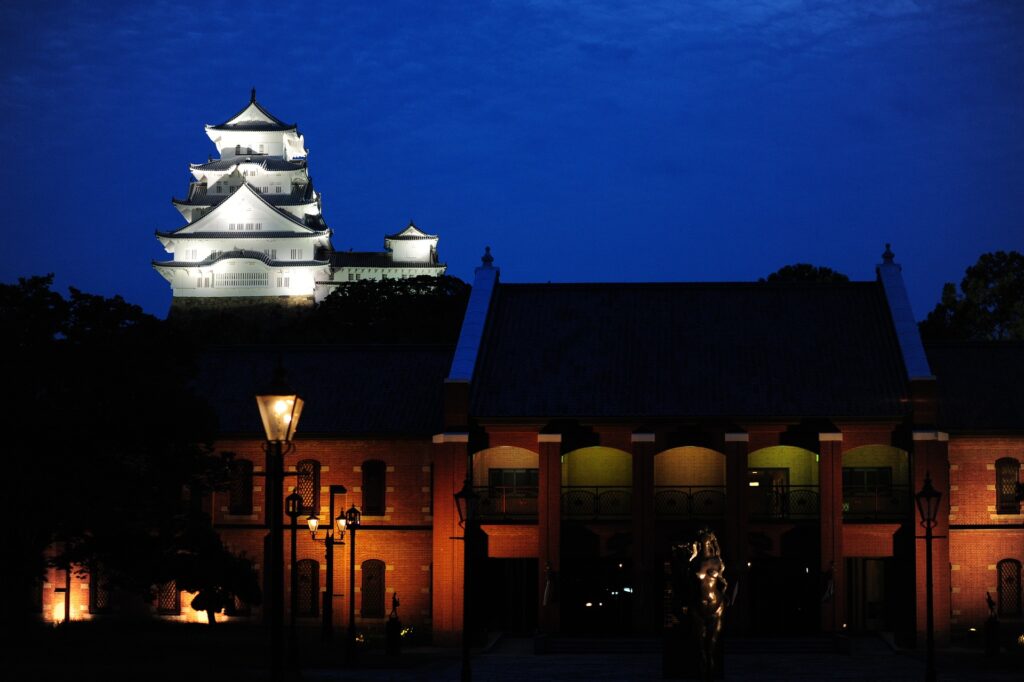
Aside from the castle, Himeji also offers other attractions, such as Koko-en, a traditional Japanese garden located next to the castle. The park has nine different sections, each with unique features such as a tea ceremony house, a bamboo grove, and a pond garden. Visitors can also enjoy the beautiful cherry blossoms during the spring season.
When visiting Himeji, Mount Shosha and Engyo-ji Temple are must-see attractions. This temple complex dates back to the 10th century and consists of several buildings and structures, such as a pagoda, a bell tower, and a meditation hall. Visitors can enjoy the beautiful scenery by taking a cable car to the temple, making it a perfect destination for sightseeing.
If you’re interested in traditional Japanese crafts, visit Aizome Traditional Japanese Indigo Dyeing Workshop in Himeji. Here, you can learn about the conventional dyeing technique and try it yourself.
Overall, Himeji is a beautiful and historic city that offers a glimpse into Japan’s rich culture and history. Whether interested in castles, gardens, temples, or traditional crafts, Himeji has something for everyone.
Tsukuba: Where Science and Innovation Soar in Japan
Nestled within the Ibaraki Prefecture of Japan, Tsukuba is a beacon of scientific achievement and innovation. Renowned as Japan’s science center, Tsukuba is home to an array of prestigious research institutes, each dedicated to unraveling the mysteries of the universe and advancing the frontiers of knowledge. Join us on a virtual journey to explore the intellectual wonders of Tsukuba.
A Science Hub: The Beating Heart of Research
Tsukuba’s fame as a science hub stems from its distinguished residents—prominent research institutions, both public and private, that span a diverse range of scientific disciplines. These include:
- Japan Aerospace Exploration Agency (JAXA): At the forefront of space exploration, JAXA conducts missions that probe the cosmos and enhance our understanding of the universe.
- Geographical Survey Institute (GSI): GSI plays a vital role in mapping and geospatial information, ensuring Japan’s landscape and resources are well-documented and utilized.
- High Energy Accelerator Research Organization (KEK): KEK delves into particle physics, striving to unlock the mysteries of the universe’s fundamental building blocks.
- National Institute for Environmental Studies (NIES): NIES is dedicated to environmental research, studying climate change, biodiversity, and sustainability to safeguard the planet.
A Global Community: Fostering Collaboration and Discovery
The diverse international presence in Tsukuba amplifies its global scientific significance. The city attracts researchers and scholars from around the globe, fostering a vibrant and diverse academic community. This intellectual melting pot is a crucible for groundbreaking discoveries and collaborative research that transcends borders.
Education and Innovation: Nurturing Future Leaders
In addition to its research institutions, Tsukuba boasts esteemed educational establishments, including the University of Tsukuba. These institutions cultivate the next generation of scientists, engineers, and thinkers, ensuring that Tsukuba’s legacy of innovation endures for future generations.
Beyond the Labs: Tsukuba’s Cultural Riches
Tsukuba is not only renowned for its scientific accomplishments, but it also boasts a diverse range of cultural opportunities. Visitors can explore art galleries, enjoy traditional Japanese cuisine, and savor the tranquility of the city’s parks and gardens.
Practical Considerations for Your Visit
If you’re planning a visit to Tsukuba, here are some helpful tips:
- Accessibility: Tsukuba is easily accessible from Tokyo by train or bus, making it an ideal day trip or a destination for those seeking to delve into its scientific and cultural offerings.
- Research Tours: Some research institutions in Tsukuba offer guided tours and public events, providing a unique opportunity to witness cutting-edge research in action. Be sure to check availability and make reservations in advance.
- Cultural Exploration: Don’t miss the opportunity to explore Tsukuba’s cultural attractions, which provide a well-rounded experience beyond science.
A Journey of Discovery and Wonder
Tsukuba is more than a city; it’s a testament to the human spirit’s unquenchable thirst for knowledge and innovation. It’s a place where scientific breakthroughs come to life, and researchers from diverse backgrounds collaborate to solve the mysteries of the universe. Tsukuba invites you to join this intellectual voyage, to be inspired by the boundless possibilities of science, and to witness firsthand the remarkable achievements that shape our understanding of the world.
Tsukuba Space Center: Embarking on a Journey to the Stars
In the heart of Tsukuba, where innovation and exploration converge, lies the Tsukuba Space Center, a crown jewel of Japan’s space endeavors. This captivating facility, the central hub of the Japan Aerospace Exploration Agency (JAXA), offers visitors a gateway to the cosmos, a place where dreams of space exploration take flight. Join us on a virtual voyage to discover the wonders of the Tsukuba Space Center.
The Gateway to the Stars: JAXA’s Premier Facility
As the primary facility of JAXA, the Tsukuba Space Center serves as the epicenter of Japan’s contributions to space exploration. Here, the frontiers of science and technology are pushed to their limits as researchers and engineers work tirelessly to advance our understanding of the cosmos.
Awe-Inspiring Exhibits: Journey into Space
Upon visiting the Tsukuba Space Center, one can indulge in many captivating exhibits and displays.
- Real-Life Rockets: Marvel at actual rockets and satellites that have traversed the vast expanse of space. These towering machines of exploration stand as testaments to human ingenuity and determination.
- Educational Displays: Engage with informative exhibits that provide insights into the history of space exploration, the challenges of living and working in space, and the cutting-edge technologies driving future missions.
- Interactive Experiences: Immerse yourself in hands-on activities that allow you to simulate the experiences of astronauts and engineers, from piloting spacecraft to conducting experiments in microgravity.
Bridging the Past and Future: A Journey of Inspiration
The Tsukuba Space Center celebrates Japan’s remarkable achievements in space exploration and serves as an educational beacon for future generations of scientists, engineers, and dreamers. Its mission is to inspire, enlighten, and kindle a passion for the mysteries of the universe.
Practical Information for Your Visit
When planning your visit to the Tsukuba Space Center, consider the following:
- Operating Hours: Check the official website for the Tsukuba Space Center’s opening hours, which may vary throughout the year.
- Guided Tours: The center often offers guided tours that provide in-depth insights into its research and missions. These tours may require booking.
- Accessibility: The Tsukuba Space Center is accessible by train and bus from Tokyo and other major cities. It is a convenient day trip or an essential stop on your journey through Tsukuba.
A Cosmic Odyssey Awaits
The Tsukuba Space Center invites you to embark on a cosmic odyssey, stand in awe of humanity’s achievements beyond Earth’s bounds, and glimpse the limitless possibilities among the stars. It’s a place where the spirit of exploration ignites, the wonders of space come alive, and visitors of all ages can share in the excitement of our ongoing voyage into the cosmos. Whether you’re a seasoned space enthusiast or simply curious about the universe, the Tsukuba Space Center promises an unforgettable journey of discovery and wonder.
Tsukuba Botanical Garden: A Global Paradise of Flora
In the heart of Tsukuba, where science and nature converge, lies the Tsukuba Botanical Garden—a testament to the rich tapestry of plant life that adorns our planet. This captivating garden is a sanctuary for plant enthusiasts and a haven for those seeking to immerse themselves in the beauty and diversity of the world’s flora. Join us on a virtual journey to discover the wonders of the Tsukuba Botanical Garden.
A Global Garden: A World of Botanical Beauty
The Tsukuba Botanical Garden is a living encyclopedia of plants, showcasing a vast collection from every corner of the globe. Here, you can wander through a landscape that transports you from the lush rainforests of South America to the arid deserts of Africa, all within the confines of this splendid garden.
Botanical Marvels: A Feast for the Senses
Visitors of Tsukuba Botanical Garden can indulge in a diverse range of captivating experiences.
- Plant Collections: Explore themed areas that house plant collections grouped by region or botanical family. Each section unveils the unique beauty and characteristics of plants worldwide.
- Greenhouses: Come and experience the greenhouses, where we carefully regulate the temperature and environment to replicate the unique conditions of different ecosystems. These glass houses allow you to encounter tropical rainforests, arid deserts, and other botanical wonders up close.
- Educational Exhibits: Engage with informative displays and exhibits that offer insights into plant ecology, conservation efforts, and the vital role of plants in sustaining life on Earth.
Botanical Conservation: Nurturing Biodiversity
The Tsukuba Botanical Garden is a place of beauty and a center for research and conservation. Scientists and botanists work diligently to protect and preserve endangered plant species, ensuring that future generations can continue to marvel at the diversity of life on our planet.
Practical Information for Your Visit
Here are some practical considerations when planning your visit to the Tsukuba Botanical Garden:
- Operating Hours: Check the official website for the Tsukuba Botanical Garden’s opening hours, which may vary seasonally.
- Guided Tours: The garden often offers guided tours led by experts who can provide in-depth insights into the plant collections and conservation efforts.
- Accessibility: The Tsukuba Botanical Garden is conveniently accessible by train or bus from Tokyo and other major cities, making it an ideal day trip for nature enthusiasts.
A Floral Paradise Awaits
The Tsukuba Botanical Garden invites you to embark on a botanical odyssey, to wander through landscapes that transport you across continents and ecosystems, and to witness the breathtaking diversity of our planet’s plant life. It’s a place where the beauty of nature is on full display, where the wonders of botany come alive, and where visitors of all ages can deepen their connection with the natural world. Whether you’re a seasoned botanist or simply a beauty lover, the Tsukuba Botanical Garden promises an unforgettable journey through the splendor of global flora.
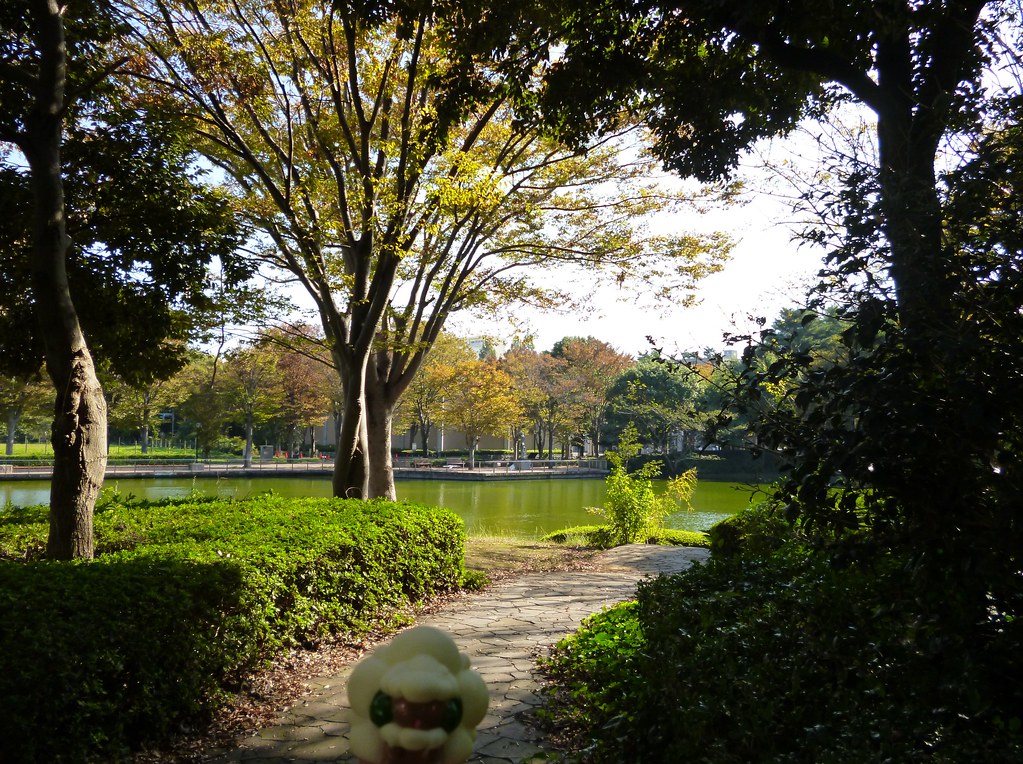
Hirasawa Kanga Ruins: Unearthing the Echoes of Kamakura’s Past
Nestled amidst the serene landscapes of Tsukuba, the Hirasawa Kanga Ruins invite intrepid explorers and history enthusiasts to embark on a captivating journey back in time. These evocative ruins are all that remain of a bustling castle town from the Kamakura period, offering a mesmerizing glimpse into a bygone era. Join us on a virtual expedition to unearth the secrets and stories hidden within the Hirasawa Kanga Ruins.
A Living Chronicle: The Kamakura Period Resurrected
The Hirasawa Kanga Ruins are a testament to Japan’s Kamakura period’s rich history and heritage. Here, visitors can traverse the remnants of a once-thriving castle town, where life unfolded against the backdrop of ancient traditions and the ebb and flow of time.
Castle Walls and Beyond: Exploring the Ruins
As you wander through the Hirasawa Kanga Ruins, you’ll encounter an array of enigmatic structures:
- Castle Walls: Marvel at the enduring stone walls that once fortified the castle, serving as guardians of the town and symbols of power and prestige.
- Wells: Discover the wells that quenched the thirst of the town’s inhabitants, drawing life-sustaining water from the depths of the earth.
- Foundations and Structures: Explore the foundations and remnants of buildings that once bustled with activity, from homes to workshops, where artisans plied their trades.
A Step Back in Time: Imagining Life in the Kamakura Period
While the physical structures of the Hirasawa Kanga Ruins offer a tangible connection to the past, they also ignite the imagination. Visitors can envision the daily lives of the castle town’s residents, conjuring images of bustling markets, artisans at work, and the rhythm of life during this transformative period in Japan’s history.
Preservation and Appreciation: Honoring the Past
Efforts to preserve and showcase the Hirasawa Kanga Ruins are a testament to Japan’s commitment to preserving its cultural heritage. These ruins serve as a living classroom where history comes alive, and visitors can better appreciate the nation’s rich legacy.
Practical Information for Your Visit
Here are some practical considerations when planning your visit to the Hirasawa Kanga Ruins:
- Accessibility: The ruins are typically open to the public, and visitors can explore the site at their own pace. Consider checking for any special exhibitions or guided tours.
- Educational Materials: Look for information boards or guides at the site that provide historical context and insights into the ruins.
- Cultural Respect: As with any historical site, please observe respect for the ruins, refrain from touching or climbing on structures, and follow any posted guidelines.
A Timeless Encounter
The captivating Hirasawa Kanga Ruins are a must-see for those interested in history and curious about Japan’s Kamakura period. Upon entering the portal, you’ll travel through time. The ancient stones and crumbling walls perfectly preserve the essence of a castle town, allowing you to immerse yourself in the experience fully. The echoes of the past reverberate throughout the ruins, allowing visitors to experience an unforgettable glimpse into a bygone era. Whether you’re a seasoned historian or a casual traveler, the Hirasawa Kanga Ruins promise a timeless encounter that invites you to unravel the mysteries and stories woven into the fabric of Japan’s rich cultural tapestry.
Chikatsu Shrine: Embracing Ancient Traditions in Tsukuba’s Historic Heart
Tucked away in the heart of Tsukuba lies the Chikatsu Shrine, an embodiment of Japan’s ancient spiritual traditions and a testament to the enduring connection between humanity and the land. As one of the oldest shrines in the Tsukuba region, Chikatsu Shrine is a revered sanctuary dedicated to the god of agriculture, drawing visitors from near and far, especially during the annual rice-planting festival. Join us as we embark on a virtual pilgrimage to explore the spiritual essence and cultural heritage of Chikatsu Shrine.
A Portal to the Past: Tsukuba’s Time-Honored Sanctuary
Chikatsu Shrine stands as a living relic, a sanctuary that has witnessed the passage of centuries. Its revered presence in the Tsukuba area echoes the enduring reverence for the land and the vital role of agriculture in Japan’s history and culture.
Spirit of Agriculture: Honoring the God of the Harvest
At the heart of Chikatsu Shrine’s significance lies its dedication to the god of agriculture. Farmers and the agricultural community have long turned to the shrine to seek blessings for bountiful harvests, fertile fields, and the prosperity of their livelihoods. The shrine’s annual rice-planting festival is a cherished event that draws locals and visitors to partake in this timeless celebration of Japan’s agricultural heritage.
Architectural Splendor: Navigating the Shrine Grounds
As you venture through Chikatsu Shrine’s serene grounds, you’ll encounter architectural marvels that reflect the elegance of traditional Japanese design:
- Main Hall: The honden, or main hall of the shrine, upholds religious customs and traditions with great reverence. Grace is a testament to Japan’s reverence for spirituality.
- Torii Gate: The towering torii gate marks the threshold between the mundane world and the sacred realm of the shrine. Passing beneath it signifies a step into a space imbued with reverence and tradition.
Practical Information for Your Visit
When planning your visit to Chikatsu Shrine and Tsukuba’s cultural and historical sites, consider these practical tips:
- Festival Calendar: If possible, align your visit with Chikatsu Shrine’s annual rice-planting festival to witness a living tradition.
- Respectful Observance: When visiting shrines and historical sites, observe customary respect, including bowing, purifying rituals, and respectful silence.
- Local Cuisine: Savor the flavors of Tsukuba by exploring local restaurants and traditional Japanese cuisine in the area.
A Journey of Reverence and Reflection
Chikatsu Shrine invites you to embark on a journey of spiritual reverence and cultural exploration. It’s a destination that reveres the customs of yore, honors the bond between people and earth, and allows guests to fully experience the intricate fabric of Japan’s past and legacy. Whether you’re a pilgrim searching for spiritual solace or a seeker of cultural riches, Chikatsu Shrine and Tsukuba offer an unforgettable experience that resonates with the essence of Japan’s soul.
Unveiling the Best of Japan: Your Ultimate Travel Guide
Are you ready to embark on an unforgettable journey to Japan, a land of rich traditions and contemporary wonders? Whether you’re a culture enthusiast, a nature lover, or a night owl, Japan has a treasure trove of experiences waiting for you. Join us as we explore some of the country’s most incredible destinations, each offering a unique tapestry of adventures.
Tokyo: Where Modernity Meets Tradition
Shibuya: Dive headfirst into the heart of Tokyo in Shibuya, a shopper’s paradise where neon lights illuminate the streets. Don’t forget to experience the world-famous Shibuya Crossing!
Shinjuku: Soar to new heights in Shinjuku, Tokyo’s skyscraper district, where you’ll find an electrifying nightlife scene alongside serene parks and historical sites.
Asakusa: Immerse yourself in the enchanting world of traditional Japanese culture in Asakusa. Explore the iconic Senso-ji Temple and stroll down Nakamise Shopping Street.
Kyoto: A Timeless Journey through History
Fushimi Inari Taisha: Wander through a mesmerizing tunnel of red torii gates at Fushimi Inari Taisha, a shrine nestled amidst tranquil forested hills.
Kinkaku-ji: Behold the ethereal beauty of Kinkaku-ji, the “Golden Pavilion,” set amidst exquisite gardens and shimmering waters.
Arashiyama: Find serenity in the breathtaking landscapes of Arashiyama, where bamboo forests, scenic rivers, and historic bridges create a poetic setting.
Hiroshima: Reflection and Resilience
Peace Memorial Park: Pay your respects at Hiroshima’s Peace Memorial Park, a poignant reminder of the city’s tragic past and unwavering commitment to a peaceful future.
Miyajima Island: Bask in the tranquil vibes of Miyajima Island, where friendly deer roam freely, and the iconic Itsukushima Shrine appears to float on the serene waters.
An Adventure Awaits in the Land of the Rising Sun
Japan is a country of boundless beauty and captivating contrasts, where ancient traditions harmonize with modern innovation. Whether you’re exploring the electric streets of Tokyo, traversing the timeless landscapes of Kyoto, or paying homage to history in Hiroshima, each destination promises a unique and unforgettable experience.
So, prepare for an epic journey through Japan’s diverse landscapes, rich cultural heritage, and vibrant cities. Japan is calling, ready to immerse you in a tapestry of wonder, and it’s time to answer the call. Your adventure of a lifetime awaits in the Land of the Rising Sun!
- The Best Waterfalls in Kyushu: Enjoying the Island’s Natural Beauty
- The Best Parks in Tokyo That Will Amaze You
- “Top of the World: Mystical Summit Experience Of Mount Fuji”
- “Kumamoto Serenity: Unmasking The Secrets Of Its Natural Wonders”
- The Best Beach Resorts in Shikoku
- Shibuya: https://www.japan-guide.com/e/e3007.html
- Shinjuku: https://www.japan-guide.com/e/e3011.html
- Asakusa: https://www.japan-guide.com/e/e3004.html
- Shopping: https://www.timeout.com/tokyo/shopping/the-50-best-shops-in-tokyo
- Entertainment: https://www.timeout.com/tokyo/things-to-do/best-things-to-do-in-tokyo
- Nightlife: https://www.timeout.com/tokyo/nightlife/best-nightlife-in-tokyo
- Observation deck: https://www.timeout.com/tokyo/things-to-do/best-observation-decks-in-tokyo
- Department store: https://www.tokyoweekender.com/2019/09/tokyo-department-stores-the-ultimate-guide/
- Traditional Japanese culture: https://www.japan-guide.com/e/e623.html
- Sensoji Temple: https://www.japan-guide.com/e/e3001_asakusa.html
- Nakamise Shopping Street: https://www.japan-guide.com/e/e3004.html#a_nakamise
- Fushimi Inari Taisha: https://www.japan-guide.com/e/e3915.html
- Vermilion torii gates: https://www.japan-guide.com/e/e3915.html
- Kinkaku-ji (Golden Pavilion): https://www.japan-guide.com/e/e3908.html
- Zen temple: https://www.japan-guide.com/e/e3919.html
- Arashiyama: https://www.japan-guide.com/e/e3912.html
- Bamboo forest: https://www.japan-guide.com/e/e3915.html
- Hozu River: https://www.japan-guide.com/e/e3990.html
- Tenryu-ji temple: https://www.japan-guide.com/e/e3912.html
Hiroshima:
- Atomic bomb: https://www.history.com/topics/world-war-ii/hiroshima
- Hiroshima Peace Memorial Park: https://www.japan-guide.com/e/e3401.html
- Atomic Bomb Dome: https://www.japan-guide.com/e/e3401.html#a_bomb_dome
- Peace Memorial Museum: https://www.japan-guide.com/e/e3401.html#a_museum
- Children’s Peace Monument: https://www.japan-guide.com/e/e3401.html#a_children
- Sadako Sasaki: https://www.hiroshima-navi.or.jp/en/post/005136.html
- Paper cranes: https://www.history.com/news/the-legend-of-the-1000-paper-cranes
- Miyajima Island: https://www.japan-guide.com/e/e3401.html#section_miyajima
- Itsukushima Shrine: https://www.japan-guide.com/e/e3401.html#section_miyajima
- Daisho-in Temple: https://www.japan-guide.com/e/e3450.html
- Mount Misen hiking trail: https://www.japan-guide.com/e/e3450.html#section_hiking

















